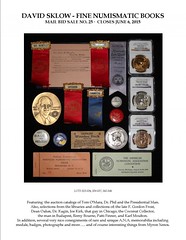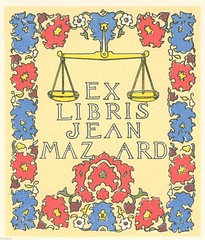
About UsThe Numismatic Bibliomania Society is a non-profit organization devoted to the study and enjoyment of numismatic literature. For more information please see our web site at coinbooks.org SubscriptionsThose wishing to become new E-Sylum subscribers (or wishing to Unsubscribe) can go to the following web page link MembershipThere is a membership application available on the web site Membership Application To join, print the application and return it with your check to the address printed on the application. Membership is only $20 to addresses in the U.S., $25 for First Class mail, and $30 elsewhere. For those without web access, write to: David M. Sundman, Treasurer
AsylumFor Asylum mailing address changes and other membership questions, contact David at this email address: dsundman@LittletonCoin.com SubmissionsTo submit items for publication in The E-Sylum, just Reply to this message, or write to the Editor at this address: whomren@gmail.com BUY THE BOOK BEFORE THE COINSale Calendar |
- WAYNE'S WORDS: THE E-SYLUM APRIL 26, 2015
- SKLOW MAIL BID SALE #25 CATALOG AVAILABLE
- NEW BOOK: BANKNOTE YEARBOOK 9TH EDITION
- NLG 2015 WRITERS’ COMPETITION NOW OPEN
- BOOK REVIEW: THE NAPOLEON OF CRIME
- BOOK REVIEW: COINS & COLLECTORS
- BOWERS SEEKS HIGH-END LIBERTY SEATED INFORMATION
- WHAT HENNING SET OUT TO COUNTERFEIT
- NOTES FROM E-SYLUM READERS: APRIL 26, 2015
- EDITOR CHANGES AT COIN WORLD
- HOW THE SWITT FAMILY WON BACK THE 1933 DOUBLE EAGLES
- 1907 ULTRA HIGH RELIEF DOUBLE EAGLE OFFERED
- THE APOLLO 13 FLOWN SILVER ROBBINS MEDALLION
- THE PULITZER PRIZE MEDAL
- LEARN OF US: THE BEEHIVE ON MEDALS
- HANS SLOANE MEDALS
- VIENNA CONFERENCE ON JOSEPH ECKHEL
- THE 1798 BANK OF PENNSYLVANIA HEIST
- MORE ON VICTOR DAVID BRENNER’S LINCOLN DESIGN
- MORE ON THE SILVER DOLLARS OF 1895
- OFF-CENTER 1921-D MORGAN DOLLAR
- HARVEY STACK RECALLS SHAPIRO, KAGIN AND STEINBERG
- THE ORIGINAL MONTROVILLE DICKESON PHOTO
- READER TAKES ON BANKNOTE DESIGN
- THE POLISH 20 PLN NOTE BY ANDRZEJ HEINDRICH
- 1874 TREATY 4 MEDAL ON DISPLAY
- THE COLLECTOR OF MEDALS BY DANIEL DUPUIS
- QUERY: JENNY LIND MEDAL OVERSTRUCK ON MEXICAN 2R
- MESZAROS DESIGN WINS AMERICAN MEDAL OF THE YEAR
- MICHAEL ALEXANDER VISITS FRANKFURT’S HISTORICAL MUSEUM
- SHIPS ON ANCIENT COINS
- SELECTIONS FROM THE SLANEY COLLECTION OF ENGLISH COINS
- THE COLLECTION OF ALEXANDRE CARATHÉODORY PASHA
- INDIA WANTS ITS TEMPLES TO PART WITH THEIR GOLD
- 2015 MEMPHIS PAPER MONEY SHOW SPEAKERS
- BOSTON GROUPS GATHER FOR ROCKWELL MEMORIAL AWARD
- WILLIAM HARVEY AND COIN'S FINANCIAL SCHOOL
- KEN POTTER'S MICHIGAN GOOD FOR TOKENS
- ILLINOIS TOLLWAY DROPPING COIN BUCKETS
- GOLD BAR RECOVERED FROM ARMORED CAR ROBBERY
- MACQUARIE MINT THREATENED OVER COPYRIGHTED IMAGE USE
- PNG SEEKS MORE NUMISMATIC INTERNS
- FEATURED WEB PAGE: COLLECTING U.S. TOKENS
Click here to access the complete archive
To comment or submit articles, reply to whomren@gmail.com
WAYNE'S WORDS: THE E-SYLUM APRIL 26, 2015

New subscribers this week include: Rachel Foreman, courtesy of Bruce Wonder; Fiona Pyle of Token Publishing Ltd; Joseph Esposito, and Hubert Emmerig. Welcome aboard! We now have 1,852 subscribers.
This week we open with an update from David Sklow, one new book and two reviews. Other topics include the 1933 Double Eagles, Editor changes at Coin World, the Pulitzer Prize medal, Joseph Eckhel, banknote design, ships on ancient coins, and the origin of the word "drib."
To learn more about the Napoleon of Crime, the Cardinal Leopoldo de’ Medici collection, naked lady medal collectors, the 1820 Northwest "Beaver" token, the 1874 Treaty 4 medal, Honoris Causa and Cohortis Speculatorum, read on. Have a great week, everyone!
Wayne Homren
Editor, The E-Sylum
SKLOW MAIL BID SALE #25 CATALOG AVAILABLE
The catalog for MBS Sale # 25 Closing June 6, 2015 is now posted on line at our web site. For your convenience it is also attached here as a PDF. The print catalogs will be mailed the first week of May. There are No changes to the terms of sale.
David Sklow-Fine Numismatic Books
P.O. Box 6321
Colorado Springs, CO 80934
PH: 719-302-5686
FAX: 719-302-4933
Email: numismaticbooks@aol.com
Web Site: FineNumismaticBooks.com
NEW BOOK: BANKNOTE YEARBOOK 9TH EDITION
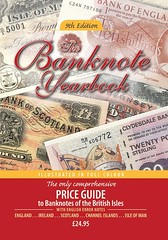 The latest edition of the acclaimed BANKNOTE YEARBOOK is now available!
The latest edition of the acclaimed BANKNOTE YEARBOOK is now available!
Banknote Yearbook 9th Edition
- Profusely illustrated in FULL COLOUR THROUGHOUT
- Essential guide to the banknotes of England, Scotland, Ireland (Northern Ireland and the Republic), the Channel Islands and the Isle of Man
- Fully updated for 2015 with ALL PRICES revised in line with market movements,
- This hardbound, easy to use reference is an absolutely essential addition to any notaphile’s bookshelf!
Once again all English notes are graded in three conditions, the English errors and misprints section has been expanded and of course all the new notes issued in the past two years have been added. As with the previous edition the hard cover, sewn bound format will ensure that this valuable reference work remains in pristine condition.
Title: Banknote Yearbook 9th Edition
Edited By: John Mussell
Publisher: Token Publishing Ltd
ISBN: 978 1 908828 21 7
Publication Date: April 2015
Price: £24.95
Category: Banknotes
Format: Hardback
Pagination: 532pp
Trade discounts: 1-10 copies 35% + CARRIAGE
11+ copies: 50% + CARRIAGE
For more information, or to order, see:
http://tokenpublishing.com
NLG 2015 WRITERS’ COMPETITION NOW OPEN
 The Numismatic Literary Guild is now accepting entries for its 2015 Writers’
Competition. The contest covers a broad spectrum of categories, including books on numismatic subjects; newspaper and magazine articles and
columns; online websites, articles, columns and blogs; numismatic newsletters; auction catalogs; and TV, radio and audio-visual
presentations.
The Numismatic Literary Guild is now accepting entries for its 2015 Writers’
Competition. The contest covers a broad spectrum of categories, including books on numismatic subjects; newspaper and magazine articles and
columns; online websites, articles, columns and blogs; numismatic newsletters; auction catalogs; and TV, radio and audio-visual
presentations.
To be eligible for consideration, entries must have been published, posted, broadcast or presented between May 1, 2014 and April 30, 2015.
Complete details, including categories, entry requirements and submission information, can be found on the NLG website, www.nlgonline.org. Entries must be received by June 15, 2015.
Winners will be announced at the 2015 NLG Bash, which will be held on the night of Thursday, Aug. 13, in Rosemont, Ill., during the 2015 World’s Fair of Money. Award plaques bearing the official NLG logo will be presented to winners during the Bash.
The Numismatic Literary Guild, founded in 1968, is an organization made up of several hundred writers, authors, editors, publishers, photographers, catalogers, curators and other individuals from around the world who are engaged in publicizing and promoting numismatics through writing and related skills.
The Guild holds a Symposium each year on timely issues affecting its members; stages the annual Bash – which, besides the award presentation, features a lavish buffet and hobby-related skits and song parodies; and publishes a newsletter.
Membership information can be found at the NLG website.
To visit the NLG web site, see:
www.nlgonline.org

BOOK REVIEW: THE NAPOLEON OF CRIME
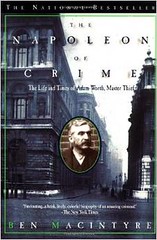 Allow me to enthuse about The Napoleon of Crime by Ben Macintyre (Farrar, Straus and Giroux, 1997),
which is the biography of Adam Worth, who began his life of crime as a Civil War bounty-jumper before maturing as a bank robber. He is
credited with masterminding the 1869 robbery of the Boylston National Bank in Boston, which was accomplished by the robbers tunneling into
the bank from the adjacent building.
Allow me to enthuse about The Napoleon of Crime by Ben Macintyre (Farrar, Straus and Giroux, 1997),
which is the biography of Adam Worth, who began his life of crime as a Civil War bounty-jumper before maturing as a bank robber. He is
credited with masterminding the 1869 robbery of the Boylston National Bank in Boston, which was accomplished by the robbers tunneling into
the bank from the adjacent building.
Astute fans of Sherlock Holmes will, of course, recognize this technique from The Red-headed League. Worth was also a planner and sponsor of heists carried out by others, which led to him being credited as the inspiration of Professor Moriarty.
Worth was pursued throughout his career by William Pinkerton, who, of course, came to admire him and helped support him and his children at the end of his life.
I found the book very readable and interesting in its depiction of crime and finance in the latter half of the 19th century, as well as including a nice number of end-notes. While it doesn’t directly bear on numismatics, it provided me with a lot of context regarding financial practices of the time.
For more information on Amazon.com, see:
The Napoleon of Crime: The Life and Times of Adam Worth,
Master Thief (www.amazon.com/The-Napoleon-Crime-Times-Master/dp/0385319932)
BOOK REVIEW: COINS & COLLECTORS
Dennis Tucker of Whitman Publications writes:
Mike Nottelmann of “Coin Show Radio” has given an enthusiastic review of Coins and Collectors.
 Coins & Collectors – Golden Anniversary Edition by Q. David Bowers
Coins & Collectors – Golden Anniversary Edition by Q. David Bowers
Being a fan of numismatic history, I can find myself lost in reference books for hour after hour learning new facts, but I particularly enjoy when I find a book that goes beyond just facts and figures and tells me the stories and the history of rare coins and how they came to be famous.
This past year, Whitman released a Golden Anniversary Edition of a book written by Q. David Bowers that I had never seen before. That it took 50 years to publish the second edition of this book is a bit puzzling, as I would think that it would be a well-established hallmark work of coin collecting. Renowned by collectors for years because of its stories that bring the history of numismatics to life.
Coin & Collectors highlights events and significant people in American numismatic history. From the very beginnings of the United States Mint and the minting of the 1792 Half Disme, to the roll collecting craze of the 1950s and the subsequent hoarding of the 1950-D Five Cent piece, from the story of Carson City Morgan Dollars to that of King Farouk and his 1933 Double Eagle, Coins & Collectors helps you to understand exactly how people have influenced history and how that history has changed numismatics.
Covered within its almost 400 pages are tales of the coins and the people who have shaped not only our hobby, but the history of money in the United States. Did you know that at one (and only one) time in our history, the US had no national debt at all? And that the time immediately following is known as the “Hard Times”? President Andrew Jackson not only abhorred debt, but he was obsessed with eliminating it, and because of this, we have an entire era of interesting tokens to collect. The legends and mottoes used on Hard Times tokens tell the story of public sentiment in their own words, and when the background story is told, the events make more sense, and to me, seem more plausible. It is this kind of understanding that makes history come to life and through this deeper understanding, the lessons of history become useful to future generations.
Major hoards, important collections, and the people that assembled them are also highlighted. From Harry Bass to Emory Mae Holden Norweb and Louis Eliasberg, Coins & Collectors teaches why these names are legends in our hobby and through this we can gain real appreciation of their grand accomplishments. Having not seen an original First edition of this book, I can only assume that Bowers has updated some of these stories in the new version to update us on significant changes as the intervening years have passed and bring the history up to date.
His easy to read story telling writing style makes for an enjoyable book that will provide hours of reading pleasure. Illustrations are plentiful and well suited to the articles. Bowers’ topics stand well on their own and the chapters are so well-contained, that it can be read like a book of short stories if you prefer. You needn’t rely on context from chapter to chapter, you can “sip and skip” through the book if you choose to browse as subjects suit your fancy.
A particularly strong point in my opinion is the wide variety of subjects addressed in this book. The Civil War paper money of Montgomery, Alabama, the National Numismatic Collection at the Smithsonian Institution, Feuchtwanger Cents, tokens, medals and even the story of a Silver Dollar that sold for $10 Million.
Bowers discusses the changes in technology utilized by the US Mint and the digital artists of today. He shares thoughts on the latest Quarter Dollars from his home state of New Hampshire, their designs, and the people responsible for creating them.
Coins & Collectors is a book that you can grab when you only have a few minutes to spare, or an entire afternoon to study. I have enjoyed reading the stories and as with all Bowers books, have expanded my knowledge by doing so.
As I read this book, I often wondered why I had never seen a copy of edition one, and why it took nearly 50 years for an update. This book is not only one that I endorse, but a book that ranks as one of my favorites in the numismatic realm. I would recommend this book to readers of all ages who want to learn about our hobby and the stories of the people who have shaped it.
To read the complete article, see:
Coins & Collectors – Golden Anniversary Edition by Q. David Bowers
(www.coinshowradio.com/archives/970)
To read the earlier E-Sylum articles, see:
NEW BOOK: COINS AND COLLECTORS: GOLDEN ANNIVERSARY EDITION
(www.coinbooks.org/esylum_v17n09a03.html)
BOOK REVIEW: COINS AND COLLECTORS GOLDEN EDITION
(www.coinbooks.org/esylum_v17n45a05.html)
BOOK REVIEW: COINS AND COLLECTORS, GOLDEN ANNIVERSARY EDITION
(www.coinbooks.org/esylum_v18n09a04.html)
BOWERS SEEKS HIGH-END LIBERTY SEATED INFORMATION

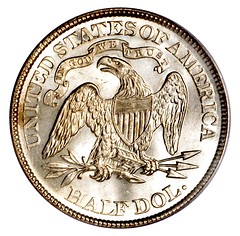
I am in the home stretch on the manuscript for A Guide Book of Liberty Seated Silver Coins, to be issued by Whitman Publishing LLC. This will cover the history and background of each of the denominations plus will have a listing for each date, mintmark, and types or date and letter sizes within each listing. It will not be a substitute for the technical die varieties listed by Messrs. Valentine, Greer, Fortin, Briggs, Brunner, Frost, Bugert, Wiley and others, but will no doubt draw a lot of attention to those studies as well as to the Liberty Seated Coin Club. Whitman will be distributing many copies nationwide.
It will have information concerning the mintage and distribution of each date and mintmark and estimated rarities within several grade categories.
To finesse the number of higher-end coins known among rare issues I desire to correspond with anyone having PCGS or NGC certified coins of which fewer than 10 or so are believed to exist in grades of MS-64 and above. On request any information supplied will be kept in confidence. I will reply to all inquiries.
As the manuscript draws to a conclusion I will send copies to interested specialists for peer review, corrections, and suggestions. I have been in correspondence with several in this regard. Len Augsburger has written the foreword to the book.
Thank you for any interest you may take.
All good wishes,
Dave Bowers
qdbarchive@metrocast.net

WHAT HENNING SET OUT TO COUNTERFEIT
Last week we quoted a recent newspaper article:
Francis LeRoy Henning of Erial may not be a household name to most folks in New Jersey, but to treasure hunters and coin collectors, Henning's name is notorious for counterfeiting what coin enthusiasts call "The 1944 Henning Nickel."
In the early 1950s, Henning, a counterfeiter by trade, set out to fake Jefferson nickels from the World War II era (1942-45).
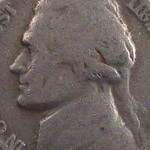 Tom
DeLorey writes:
Tom
DeLorey writes:
Henning did not set out to counterfeit nickels from the World War II era. He chose several random coins from circulation to use as models for his obverse dies, and used coins dated 1939, 1944, 1946, 1947, 1953 and apparently one other year. He got caught because his World War II era counterfeits, dated 1944, did not have the proper reverse with a large mint mark.
You will note the reference in my citation to Collectors Clearinghouse, which used to be a powerful force in the hobby for figuring out odd coins such as the Henning nickels and numerous die varieties and error coins. I had the privilege of working there from 1974 to 1978, though the Henning nickels were written up long before I got there.
To read the earlier E-Sylum articles, see:
HENNING COUNTERFEIT NICKELS SOUGHT IN RIVER
(www.coinbooks.org/esylum_v18n16a19.html)
COUNTERFEITING CIRCULATING COINS (www.coinbooks.org/esylum_v07n13a09.html)
NOTES FROM E-SYLUM READERS: APRIL 26, 2015
American Geographical Society Medal
Paul Bosco reminds us of two numismatic connections to the American Geographical Society mentioned in two previous items. First is a
reminder of the fact that the AGS was once a neighbor of the ANS on Audubon Terrace in New York City. And second, this great medal
depicting its building, available for sale on his web site, www.pauljbosco.com. Thanks!
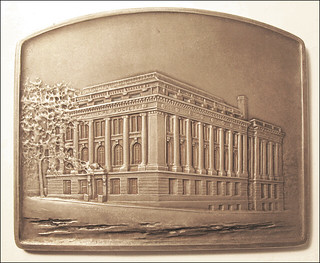
United States, American Geographical Society, Dedication of Building on Audubon Terrace (former site of the American Numismatic Society, now Boricua College), 1912, named on reverse to Gottfried Merzbacher, by Tiffany, silver, 92 x 75 mm., Choice EF, $1,250.
To read the earlier E-Sylum articles, see:
THE AMERICAN GEOGRAPHICAL SOCIETY LIBRARY
(www.coinbooks.org/esylum_v18n15a30.html)
NOTES FROM E-SYLUM READERS: APRIL 19, 2015 : On the American Geographical Society
Library (www.coinbooks.org/esylum_v18n16a11.html)
The 1820 Northwest "Beaver" Token Market
Last week Dave Wnuck discussed his early career experience attempting to specialize in Higley coppers. Paul Bosco writes:
California dealer Henry Garrett cornered the 1820 Northwest "Beaver" token market. For some years he bought them all, when they were auctioned. He said they didn't go so high; the competition lost interest, as they realized they were never going to win one. When he stopped buying and started selling, prices rose rapidly --tripled?-- as they were then perceived as collectible.
To read the earlier E-Sylum article, see:
THE HIGLEY KING AND THE PERILS OF OVER-SPECIALIZATION
(www.coinbooks.org/esylum_v18n16a14.html)
Castle Garden Token Rarity
Regarding the Castle Garden token (Rathbone & Fitch), Paul Bosco writes:
I am skeptical that the Rulau population estimate is even in the ballpark. I bet Alan Weinberg has more reliable info.
Alan V. Weinberg writes:
There are a heck of a lot more than nine specimens of the Rathbone & Fitch Castle Gardens known. A Bowers auction (American Numismatic Rarities?) fairly recently had two in one sale. I've personally owned four specimens over the years and seen perhaps seven or eight. Tru, the majority are "dug" but I have seen a nice clean Ex. Fine specimen. Steve Tanenbaum used to say he was waiting for the part red Unc that John Ford claimed to have owned.
To read the earlier E-Sylum article, see:
WAYNE'S NUMISMATIC DIARY: APRIL 19, 2015
(www.coinbooks.org/esylum_v18n16a24.html)
On Mediocrity
Regarding Mediocrity, Paul Bosco writes:
I don't know that Meyerbeer deserves such a label just because Wagner is better. Numismatically, Meyerbeer medals can go toe-to-toe with those of Wagner. There are 250+ Wagner medals; Meyerbeer pieces are few, AND are collected as Judaica.
Mark Twain has some comments on last week's issue:
Jane Austen. A good library is begun by leaving her out.
"Wagner, whose music is much better than it sounds..."
To read the earlier E-Sylum article, see:
MEDIOCRITY AND GREATNESS IN NUMISMATICS
(www.coinbooks.org/esylum_v18n16a37.html)
Silver Castorland Jeton Hoard Report
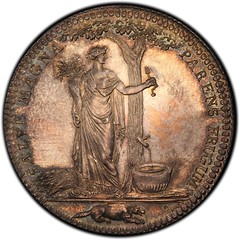 Alan V. Weinberg writes:
Alan V. Weinberg writes:
The Castorland jeton is avidly collected as a "rare" colonial coin: Back in the 1970's dealer Lester Merkin, who often traveled to Europe, told me that the family related to the original Castorland jeton issuance had a large hoard of silver originals and was releasing onto the market a few each year. Very recently a Paris-based dealer had three silver originals - all slabbed and mint state - for sale at one time on eBay. Doubtless part of this hoard.
To read the earlier E-Sylum article, see:
HELP SOUGHT FOR CENSUS OF CASTORLAND JETONS
(www.coinbooks.org/esylum_v18n16a15.html)
Doolittle Tokyo Air Raid Film
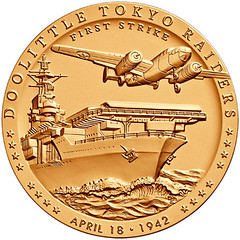 Alan V. Weinberg writes:
Alan V. Weinberg writes:
The finest motion picture covering Doolittle and the 1942 Tokyo air raid and its aftermath is the Spencer Tracy-Van Johnson MGM 1944 classic "30 Seconds Over Tokyo" which often appears on Turner Classic Movies TV No matter how many times you watch it, it's a thrill.
To read the earlier E-Sylum article, see:
DOOLITTLE TOKYO RAIDERS CONGRESSIONAL GOLD MEDAL
(www.coinbooks.org/esylum_v18n16a23.html)
On Getting Better With Time
Author Harley Spiller passed along this insightful quote via John and Nancy Wilson:
Remember what the 17th century poet Alexander Pope wrote, "Authors, like coins, grow dear, as they grow old; It is the rust we value, not the gold"
EDITOR CHANGES AT COIN WORLD
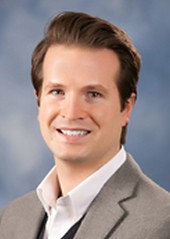

Steve Roach, Bill Gibbs
Coin World editor-in-chief Steve Roach is stepping into an editor-at-large position, with senior editor William T. Gibbs appointed to the new position of managing editor. Both changes are effective May 1.
Jeff Greisch, president of Amos Media, said April 22 to the Amos staff: “Several weeks ago, Steve Roach came to me and stated that he wished to step down as editor-in-chief of Coin World and move into an editor-at-large position, effective May 1. I have accepted his decision with regrets, but am happy that Steve will continue in a very important role with Coin World.
“As editor-at-large, Steve will continue to provide much of the editorial content that he has written during his career at Coin World as associate editor and editor-in-chief. In addition, he will continue to be a public presence representing Coin World at trade shows and conferences.
“As managing editor, Bill will be responsible for the day to day editorial management/operations of Coin World,” Greisch continued. “All the Coin World editorial staff members will report directly to him. He will continue to coordinate both print and online editorial content production.”
Greisch added: “I would like to thank Steve for his many contributions as editor-in-chief, in particular his guidance and efforts in moving Coin World into the digital age. As with all of Coin World’s editors, he has placed his stamp on the product in response to the needs of the marketplace and its constituents.”
Steve adds:
I’m excited to continue supporting the Coin World brand and working with Bill and the rest of Coin World’s staff, while at the same time having more freedom to pursue some other interests of mine.
To read the complete article, see:
Changes for editors at Coin World to be effective May
1 (www.coinworld.com/insights/changes-for-editors-at-coin-world.html)
THE BOOK BAZARRE
HOW THE SWITT FAMILY WON BACK THE 1933 DOUBLE EAGLES
 Way back in October 2005, I had lunch with an entertainment lawyer named Roy Langbord and Langbord’s own lawyer, Barry Berke of Kramer
Levin Naftalis & Frankel, to talk about a cache of exceedingly rare gold $20 coins known as 1933 Double Eagles. 1933 Double Eagles were
minted in the midst of President Roosevelt’s gold recall, and all of them were supposed to have been melted down. A handful of the coins
nevertheless disappeared from the U.S. Mint, in a theft the federal government believed to have been masterminded by Langbord’s
grandfather, a Philadelphia jeweler named Israel Switt.
Way back in October 2005, I had lunch with an entertainment lawyer named Roy Langbord and Langbord’s own lawyer, Barry Berke of Kramer
Levin Naftalis & Frankel, to talk about a cache of exceedingly rare gold $20 coins known as 1933 Double Eagles. 1933 Double Eagles were
minted in the midst of President Roosevelt’s gold recall, and all of them were supposed to have been melted down. A handful of the coins
nevertheless disappeared from the U.S. Mint, in a theft the federal government believed to have been masterminded by Langbord’s
grandfather, a Philadelphia jeweler named Israel Switt.
Switt was never prosecuted and his supposed caper would have been long since forgotten had it not been for a 1996 Secret Service sting operation to recover the only 1933 Double Eagle known to have evaded U.S. authorities. That coin, once owned by King Farouk of Egypt, was seized from a British coin dealer who brought it to the Waldorf-Astoria hotel in New York City, expecting to make the biggest sale of his career and instead ending up face down on the Waldorf’s carpet with his hands cuffed behind his back. Berke had represented that British coin dealer and not only got the criminal case dropped but managed to push the U.S. government into a historic deal in which the Farouk 1933 Double Eagle would be deemed the only one permitted to be owned privately. (Two are owned by the Smithsonian.) The government agreed to sell the Farouk coin at auction and to split the proceeds – $7.6 million, as it turned out – with Berke’s client, the British coin dealer.
Roy Langbord knew nothing of his grandfather’s past life as a suspected gold coin thief until the 2002 auction of the Farouk coin. But when he noticed a brief account of the coin’s history, he urged his mother to search the jewelry store she had inherited from her father. That search turned up the astonishing discovery of 10 additional 1933 Double Eagles, which had apparently never been removed from the hiding place where Izzy Switt stored them. The Langbords, who knew what Berke had accomplished for the British coin dealer, immediately hired him to advise them what to do with their 10 1933 Double Eagles.
The Mint had pledged in the Farouk auction that private ownership of any other 1933 Double Eagle was illegal. The government was also convinced that Switt had gotten away with stealing the coins, even though he’d been identified as the architect of the scheme in a 1940s Secret Service investigation. Berke and the Langbords knew there was no way the Mint would willingly permit Switt’s family to keep the newly discovered stash.
So Berke counseled the Langbords to send the coins to the U.S. Mint to be authenticated but to specifically preserve their ownership rights. That’s what the family did in 2004. At the time of my 2005 lunch with Berke and Langbord, when I was finishing up a book about the Farouk coin, Roy Langbord told me the family believed they’d made the best choice. “What else could we do?” he said.
The Langbord family made one of history’s great gambles when they turned over those 10 1933 Double Eagles to the Mint for authentication. On Friday, a split panel of the 3rd U.S. Circuit Court of Appeals ordered the government to return the coins to the Langbords. The U.S. Attorney’s office in Philadelphia told my Reuters colleague Jon Stempel that the government is considering its options for appeal, but if the decision holds up, the Langbord family will be the proud owners of 10 coins worth millions of dollars, even though both a judge and a jury have determined that their father and grandfather stole the coins.
That outcome is the direct result of smart litigation calculations by Berke and the Langbords and corresponding mistakes (albeit understandable ones) by the government.
So what happens now to the coins? A split panel decision usually means a request for en banc review by the losing party, in this case, the government. And considering that the government has been litigating over 1933 Double Eagles since 1996, when the Secret Service seized the Farouk coin, it doesn’t have much to lose from an en banc petition. The Justice Department also may have an institutional interest in striking down precedent holding that if it doesn’t bring a forfeiture action within 90 days of receiving a seized asset claim, it surrenders its right to the disputed property.
It would be intriguing if the anonymous winning bidder for the Farouk coin – who paid $7.6 million under the Mint’s assurance that the Farouk coin would be the only 1933 Double Eagle permitted to remain in private hands – were to bring an action against the government since 10 more coins have been legitimized. I suspect that Berke – who is now best known as defense counsel for former SAC Capital portfolio manager Michael Steinberg – has had enough of Double Eagle litigation after 19 years. But maybe his Kramer Levin partner Eric Tirschwell, who worked with Berke on the Langbord case, is up for another round.
To read the complete article, see:
How heirs of
alleged rare coin thief won gamble against U.S. Mint
(http://blogs.reuters.com/alison-frankel/2015/04/20/how-heirs-of-alleged-rare-coin-thief-won-gamble-against-u-s-mint/)
To read the complete article, see:
American Government Must Return $80 Million
Worth of Seized Gold Coins to Thief's Family
(https://news.artnet.com/art-world/80-million-coins-returned-to-thiefs-family-290286)
Paul Bosco adds:
I am not at all sure the ruling gives the Langbord family TITLE to the 1933 coins. I don't believe the ruling addressed the issue of whether or not the coins were stolen property. I would think the government could sue for the coins after restoring possession to the family. Also, anyone acquiring one of the coins might find himself/herself the victim of a civil forfeiture procedure
Alan V. Weinberg adds:
If this appeal stands and the ten coins are returned, the Federal gov't will have to refund the $7.5M to the Farouk specimen auction buyer (rumored to not be a numismatist) as the paperwork on the transaction reportedly guaranteed the auction buyer that no other 1933 $20 would ever legally sell or be legally held.
Whether the Feds will honor this promise or have to be sued (good luck!) is highly speculative. Moreover, if the ruling stands, there are other 1933 $20's in the wings - per Julian Leidman's recent story.
It is entirely reasonable to believe that there are another ten 1933 20's, aside from the Langbord's ten 1933 $20's, in collectors' hands in the US and Europe and that they will surface once the Langbord case is resolved in their favor. Ted Naftzger alone is reported to have owned three or four at one time (per several dealers who knew him well) . And that was in the 60-70's, well after the US went around confiscating them.
To read the earlier E-Sylum article, see:
COURT ISSUES RULING ON CONFISCATED 1933 DOUBLE EAGLES
(www.coinbooks.org/esylum_v18n16a10.html)
ANOTHER 1933 DOUBLE EAGLE SIGHTING REPORTED
(www.coinbooks.org/esylum_v18n15a14.html)
1907 ULTRA HIGH RELIEF DOUBLE EAGLE OFFERED
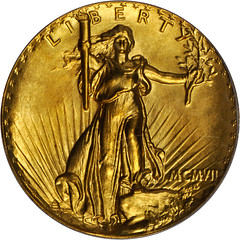
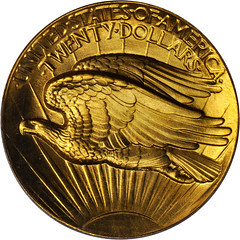
Stack’s Bowers Galleries and Sotheby’s are pleased to announce the consignment of the finest certified 1907 Ultra High Relief double eagle, arguably the most beautiful coin design ever struck by the U.S. Mint. Graded and encapsulated by the Professional Coin Grading Service as Proof-69, this example last sold in the June 2012 Stack’s Bowers Baltimore sale for $2,760,000.
The historical importance of this classic type cannot be overstated, and whenever an example is offered in auction, it creates excitement among numismatists. The story of the creation of this rarity has often been told in books and auction catalogs. In short: The coin, minted in 1907, has the date expressed in Roman numerals as MCMVII. It is one of about 20 coins with Ultra High Relief or sculptured detail. The story goes back to President Theodore Roosevelt in 1905 when he employed Augustus Saint-Gaudens, America’s most famous sculptor, to redesign the coinage. The artist, working in his studio in Cornish, New Hampshire (now a National Historic Site), began with the $20 gold double eagle, the largest denomination gold coin.
For the obverse he created a bold image of Miss Liberty in the figure of Victory, striding forward holding a torch and palm branch with the U.S. Capitol in the distance. For the reverse, an eagle in flight was sculpted. In early 1907 about 20 coins were struck at the Philadelphia Mint and given to the president and dignitaries. Due to striking difficulties, the relief was lowered to what is referred to as the High Relief, and 11,250 examples were struck for general circulation. The “ultra” high relief of the devices was inspired by the ancient Greek coins that President Roosevelt had admired in museums.
Today, several of the MCMVII Ultra High Relief coins are in museums, including one on display at the Smithsonian, and time and again surveys among numismatists have rated this as America's most beautiful coin design. It is ranked as number 7 of the Greatest 100 U.S. Coins in the popular coffee-table reference of the same title. Only rarely is one available at auction, and its appearance inspires great enthusiasm from coin collectors and those who appreciate fine art. The Ultra High Relief double eagle has always had a great allure, and has often broken records when sold at auction. In 1974, when we sold the Ulmer Collection, his example was the first coin to sell for $200,000 in auction.
“Stack’s Bowers Galleries has offered several Ultra High Relief double eagles over the years, and each time, they create much excitement and anticipation among collectors,” Lawrence R. Stack declared. “Among the famous examples are the Ulmer coin offered in 1974, the Eliasberg specimen in 1982, and most recently this example which we last offered in June 2012.”
“This is truly an American masterpiece, a work of sculpted art, as much as it is a classic numismatic rarity,” added Brian Kendrella, president of Stack’s Bowers. “We are pleased to be able to again offer this wonderful piece, not only to our list of clients, but to the clients of Sotheby’s.”
THE APOLLO 13 FLOWN SILVER ROBBINS MEDALLION


Apollo 13 Flown Silver Robbins Medallion, Serial Number 156, Originally from the Personal Collection of Mission Command Module Pilot Jack Swigert, with LOA. A stunning 32mm sterling silver medal. Due to the last minute substitution of Swigert for Mattingly and the problems that prohibited Apollo 13 from accomplishing its mission, all of the original flown medallions were melted down. This is one of 404 newly-designed sterling silver medallions that were struck from the flown metal.
The design features the mission insignia depicting the name of the mission, three of Apollo's chariot horses flying toward the Moon, and the slogan "Ex Luna, Scientia" ("from the moon, knowledge"). The reverse features the names of the crewmembers, the modules, Aquarius (lunar) and Odyssey (command), the engraved dates of launch and return, the serial number, and the sterling and Robbins hallmarks. Robbins medallions from the collections of crewmembers of the particular flight are quite desirable to collectors. The original plastic Robbins case with numbered sticker on the bottom is included. Gorgeous.
Included with this lot is a Letter of Authenticity signed by Jack Swigert's sister, Virginia Swigert, certifying "that this Apollo 13 Flown Robbins Medal - Serial Number 156 - is from Jack Swigert's personal collection" and that it comes directly from his estate.
To read the complete lot description, see:
Apollo 13 Flown Silver Robbins Medallion
(http://historical.ha.com/itm/explorers/space-exploration/apollo-13-flown-silver-robbins-medallion-serial-number-156-originally-from-the-personal-collection-of-mission-command-module-pilot-jack-swigert-with-loa/p/6139-15008.s)
THE BOOK BAZARRE
THE PULITZER PRIZE MEDAL
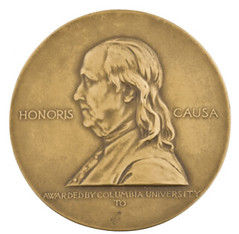
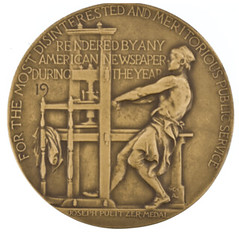
The Pulitzer Prize(s) have been awarded annually since 1917 for excellence in journalism, arts, and letters. They are the legacy of the Hungarian-born American newspaper publisher Joseph Pulizter (1847-1911), and the 2015 winners were announced yesterday for what are now twenty-one separate categories. Although the Pulitzer medal has come to symbolize the program, the only winner that actually receives a medal is the organization that receives the award for “disinterested and meritorious” Public Service, which this year went to Charleston’s The Post and Courier newspaper. The other awardees receive a certificate and ten-thousand dollars, which must be some consolation.
The medal was designed by the noted American sculptors Daniel Chester French (1850-1931) and Augustus Lukeman (1872-1935), who were both better-known for their monumental work. As the awards were being organized in line with Pulitzer’s will, Columbia University President Nicholas Murray Butler commissioned French to make a medal with an image of the most celebrated newsman in American history, Benjamin Franklin.
The model for the obverse is presumed to be a marble bust by the French sculptor by Jean Antoine Houdon at the Metropolitan Museum of Art, where Daniel Chester French was a trustee. The reverse was originally intended to simply be text, but as they were modeling it French and Lukeman thought that too plain and added an image of a man working an early printing press. Although this touch was welcomed, the design went through several revisions before an image of a bare-chested printer straining at the press was chosen.
Done in the reigning Beaux-Arts style, it is a very well-executed design and very fitting for a journalism award. The American Numismatic Society’s medal is obviously an un-awarded example. There are blank spaces where the name of the winning organization would be inscribed in the exergue on the obverse and for the date above the printing bed on the reverse. The legend HONORIS CAUSA simply means “for the sake of the honor,” while the descriptive text on the back is the language from the citation. The Joseph Pulitzer medal is a truly wonderful example of American medallic art, and one undoubtedly appropriate for what has become the most prestigious honor in journalism.
To read the complete article, see:
THE PULITZER MEDAL (www.anspocketchange.org/the-pulitzer-medal/)
LEARN OF US: THE BEEHIVE ON MEDALS
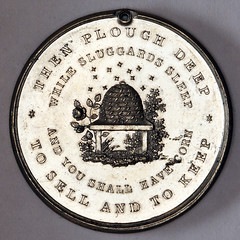
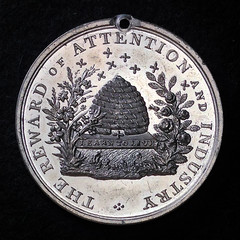
All of the medals we collect were originally created for some primary purpose. Some were commemorative, some awards, some commercially produced for sale to collectors or tourists, and others were purely artistic expression. Among school award medals, a number were also intended – or perhaps even primarily intended – to be instructive. They were designed to reinforce important lessons, values, or behaviors in the children who received them. One favorite device was the beehive, symbolizing the virtues of diligence and cooperation.
In Roman times, bees became a potent symbol of dedicated hard work, community, cooperation, and harmony. A bee colony is a super-organism often exceeding 50,000 workers, where no individual can survive independently, and every member of the colony has an important job to perform. Even the queen is not self-sufficient, requiring several attendant female workers to feed, warm, and protect her, and a few male drones to…well, you know (and nothing but that, incidentally). Because of this nearly unique community behavior and their perceived diligence, bees or their beehives have been adopted as central iconography by several well-known organizations that value these traits, such as the Freemasons and Mormons (and subsequently the State of Utah).
Given the bees’ diligent, hardworking, community behavior, it’s not surprising that the beehive was often used as the central device on school award medals. Beehives were certainly not the only symbols used, but they came close to being the perfect cultural object lesson for children in the late-18th through the 19th centuries, as primary education became more universal. German-speaking European countries, England and its North American offshoots, the United States and Canada, produced the greatest number of these beehive medals, but examples are also known from Denmark, Hungary, and a few other countries.
While the beehive itself was sometimes enough to get the idea across, more often the intended message is spelled out explicitly. For example, many of the English medals have legends like a simple “Industry”, “Learn Of Us”, and/or “Learn To Live”. Others have a more elaborate legend such as “By Industry We Live, By Perseverance, Excel” or “From Labour & Industry Great Blessings Flow”.
The German, Danish, and Hungarian medals tend to have a message more like “useful to themselves and others” in their native language or Latin. One of the more delightful pieces, by Joseph Davis, shows a boy on the obverse studying in front of a bust of Franklin and the legend, “God Giveth All Things To Industry”; on the reverse is a beehive surrounded by the continuation of the Franklin quotation, “Then Plough Deep While Sluggards Sleep And You Shall Have Corn to Sell And To Keep”.
So Learn Of Us Indeed!
For more information on the Medal Collectors of America (MCA), see:
www.medalcollectors.org
To read the earlier E-Sylum article, see:
THE MCA ADVISORY CIRCUS ISSUE (www.coinbooks.org/esylum_v18n16a07.html)
HANS SLOANE MEDALS
In the April 22, 2015 issue of his Fourth Garrideb blog about the Numismatics of Sherlock Holmes, Greg Ruby writes:
Upon learning of his possible share of $5 million dollars from the estate of Alexander Hamilton Garrideb, reclusive collector Nathan Garrideb was ecstatic that he could form the nucleus of a new national collection and be the next Hans Sloane. But who was Hans Sloane?
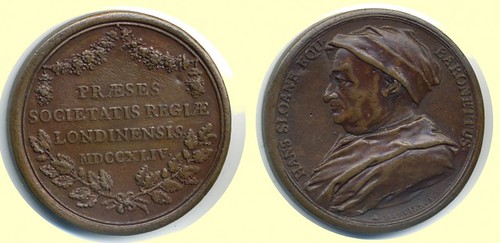
Jacques-Antoine Dassier produced this bronze medal in 1744 to honor Sloane’s Presidency of the Royal Society.
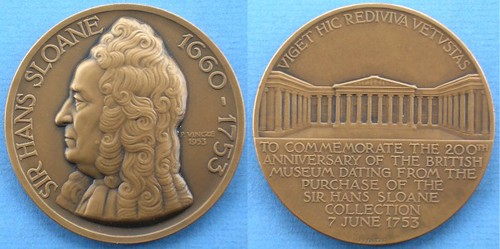
Noted sculptor Paul Vincze designed the 200th Anniversary Medal of the British Museum and it features a striking profile of Hans Sloane.

To read the complete article, see:
Numismatic Tributes of Hans Sloane
(http://fourthgarrideb.com/2015/04/numismatic-tributes-of-hans-sloane/)

VIENNA CONFERENCE ON JOSEPH ECKHEL
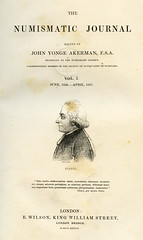 One of
the great pleasures of historical research is the occasional interaction, professionally, with numismatic subjects. I recently received an
email on a Humanities listserv about an upcoming conference in Vienna celebrating Joseph Eckhel (1737-1798), a pioneer in modern numismatic
studies. The event, set to take place May 27-30 at the Austrian Academy of Sciences (ÖAW), is convened by numismatic historian Bernhard
Woytek, and will feature almost two dozen numismatic and historical researchers from Europe and the United States, all following the path
blazed by Eckhel over two centuries ago.
One of
the great pleasures of historical research is the occasional interaction, professionally, with numismatic subjects. I recently received an
email on a Humanities listserv about an upcoming conference in Vienna celebrating Joseph Eckhel (1737-1798), a pioneer in modern numismatic
studies. The event, set to take place May 27-30 at the Austrian Academy of Sciences (ÖAW), is convened by numismatic historian Bernhard
Woytek, and will feature almost two dozen numismatic and historical researchers from Europe and the United States, all following the path
blazed by Eckhel over two centuries ago.
Eckhel’s numismatic resume appears almost fantastical. A crucial moment in the life of Eckhel, who was born and raised in Lower Austria, was a study visit to Italy in 1772/1773. In Florence, he found employment arranging the impressive collection began by Cardinal Leopoldo de’ Medici (1617-1675). Following the suppression of the Jesuit Order in 1773 and Eckhel’s return to Austria, Empress Maria Theresa appointed Eckhel as keeper of the Imperial Coin Cabinet and professor of antiquities and numismatics at the University of Vienna, a post that he would hold for more than two decades. It was in this position that Eckhel composed his magnum opus, the eight-volume Doctrina numorum veterum , a magisterial, systematic account of ancient coinage.
The conference in Vienna will examine Eckhel from multiple angles, but one theme which promises to emerge is Eckhel’s connection to the Enlightenment, a European intellectual movement that privileged analysis and reason over the inertia of static traditions. Eckhel’s research was meticulous and thoughtful, and his goals included the rational systemization of coins and their history, a quality that has drawn comparisons with botanist Carl von Linné (Linnaeus), creator of binomial nomenclature for the natural world. Other themes will include ancient glyptics, coin curation, and numismatic teaching.
An often-overlooked aspect of our hobby is that its reach extends in many directions. While this conference reveals a historical link and a connection to Humanistic research, I have no doubt that similarly exciting numismatic discussions take place in the fields of metallurgy, economics & finance, theology, art & design, and countless other areas. I’m delighted to share these occasions when they take place in my neck of the occupational woods.
You can learn more about the conference here: www.oeaw.ac.at/eckhel2015
To read the complete article, see:
THE NUMISMATIC SCIENCE
(www.coinworld.com/voices/kevin-goldberg/2015/04/the_numismatic_scien.html#)
THE 1798 BANK OF PENNSYLVANIA HEIST
 The 1798 Bank of Pennsylvania heist occurred late on August 31 or early on September 1, 1798 when $162,821 was stolen from the Bank of
Pennsylvania at Carpenters' Hall in Philadelphia, Pennsylvania.
The 1798 Bank of Pennsylvania heist occurred late on August 31 or early on September 1, 1798 when $162,821 was stolen from the Bank of
Pennsylvania at Carpenters' Hall in Philadelphia, Pennsylvania.
Patrick "Pat" Lyon, a blacksmith who had worked on the vault doors and fitted it with locks, was initially a suspect in the heist. Lyon and a 19-year-old apprentice had left Philadelphia shortly before the heist, possibly in response to a yellow fever epidemic that had been plaguing the city. They later arrived in Lewistown, Delaware, where the apprentice died of an illness. Lyon had learned of the theft and suspected that he was wanted after speaking with an acquaintance of his.
Lyon himself had suspected the bank's caretaker, Samuel Robinson, and another man of committing the heist. They had visited his shop once when he was working on the bank vault's doors. Lyon returned to Philadelphia to plead his case but was imprisoned in Walnut Street Prison for three months. The bank showed no signs of forced entry and the vault was believed to have been opened with a forged key.
The sole perpetrators of the heist, Isaac Davis and Thomas Cunningham were later caught. Cunningham, who was the bank's porter, died of yellow fever several days after the heist.[6] Davis, the man who had visited Lyon's shop with Robinson, was depositing the stolen money in several banks, including the one he had burglarized. This made officials suspicious of him and he later confessed to the heist. However, he was reportedly pardoned without serving any jail time after he gave back the stolen money in a plea deal with the Governor of Pennsylvania, Thomas Mifflin. Lyon was still kept in jail on suspicion of forging a duplicate key but released shortly thereafter. His bail had been set at $150,000 but lowered to $2,000 after Davis's confession.
Aftermath
Lyon then wrote a book on his false imprisonment titled Narrative of Patrick Lyon Who Suffered Three Months Severe Imprisonment in Philadelphia Gaol on Merely a Vague Suspicion of Being Concerned in a Robbery of the Bank of Pennsylvania With his Remarks Thereon and went to trial for damages. He was awarded $12,000 for false imprisonment. This was appealed by the defendants and the new agreed upon amount was set at $9,000.
Lyon later had his portrait painted by John Neagle, titled Pat Lyon at the Forge, depicting Lyon standing at a forge with the Walnut Street Prison visible in the background.
To read the complete article, see:
1798 Bank of Pennsylvania heist
(https://en.wikipedia.org/wiki/1798_Bank_of_Pennsylvania_heist)
To read the earlier E-Sylum articles, see:
NEW YORK'S FIRST BANK ROBBERY (www.coinbooks.org/esylum_v18n12a32.html)
AMERICA'S FIRST BANK BURGLARY?
(www.coinbooks.org/esylum_v14n20a11.html)
MORE ON VICTOR DAVID BRENNER’S LINCOLN DESIGN
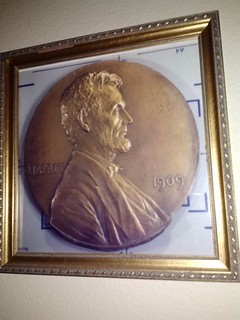
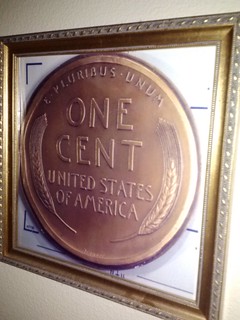
Dave Lange writes:
In the article about the Lincoln portrait model held by the ANS it was suggested by the writer that this was a preliminary model for the Lincoln Cent, but I don't believe that is correct. It is stylistically more similar to the various Lincoln medals and plaquettes that Brenner produced for years and which provided him with an income for the remainder of his life. The most obvious difference is the treatment of Lincoln's hair, which is shown on the ANS piece to be wavy, rather than curly, as on the cent. Wavy hair is far more accurate to photographs of Lincoln, and the cent has always been among Brenner's poorest representations of our 16th president.
I'm including images of framed photos that I have in my office and which appeared in my book on Lincoln Cents. These show the models that Brenner submitted to the U. S. Mint for the cent. They were, of course, modified for the final hubs, but they clearly reveal that Lincoln already had his curly hair which is seemingly unique to the coin.
I apologize for both the oblique angle and the uneven lighting, but these are framed in such a way that it would be very difficult to remove them for scanning.
Nick Graver writes:
Victor D. Brenner made the plaster profile of Abraham Lincoln working from photographs by Anthony Berger, manager of Brady’s Washington, DC gallery. Berger made seven poses at this sitting, Feb 9, 1864, and Brenner combined two of them in designing our Lincoln Cent 44 years later. They are identified as O-88 and O-89, and these notes are taken from “LINCOLN IN PHOTOGRAPHS, An Album of Every Known Pose” by Charles Hamilton and Lloyd Ostendorf, Morningside, Dayton, Ohio, 1985.
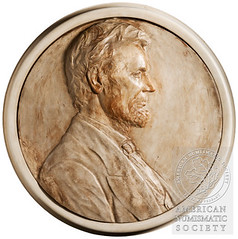
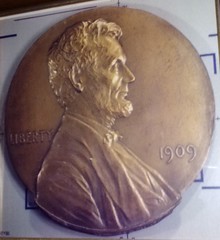
To read the earlier E-Sylum article, see:
VICTOR DAVID BRENNER’S LINCOLN PLASTER
(www.coinbooks.org/esylum_v18n16a17.html)
MORE ON THE SILVER DOLLARS OF 1895
Mr. DeLorey’s 1995 article focuses on an article by Henry T. Hettger that originally appeared in the May/June 1994 issue of Bowers & Merena Galleries’ Rare Coin Review.
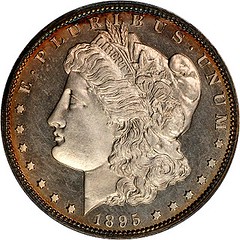 In the meantime, some additional research has been done on the 1895 silver dollars: in 2006, noted
numismatic researcher Roger W. Burdette published an article in Coin Values, the short-lived glossy magazine supplement to Coin
World. (I wish I could tell you exactly when the article appeared, but I only have the pages I removed from the magazine, which don’t
have the typical date “footer.” The article begins on page 46 of the issue and there’s an advertisement for Whitman’s Oct. 5-7, 2006
Atlanta coin show on page 49.)
In the meantime, some additional research has been done on the 1895 silver dollars: in 2006, noted
numismatic researcher Roger W. Burdette published an article in Coin Values, the short-lived glossy magazine supplement to Coin
World. (I wish I could tell you exactly when the article appeared, but I only have the pages I removed from the magazine, which don’t
have the typical date “footer.” The article begins on page 46 of the issue and there’s an advertisement for Whitman’s Oct. 5-7, 2006
Atlanta coin show on page 49.)
Mr. Burdette’s article begins by acknowledging Mr. Hettger’s article and then discusses Proof coins and the circumstances under which the Philadelphia Mint’s stockpile of silver dollars was inventoried twice during 1894 and 1895. Next, he discusses the Mint’s accounting processes and the circumstances under which 12,000 silver dollars were struck in June 1895.
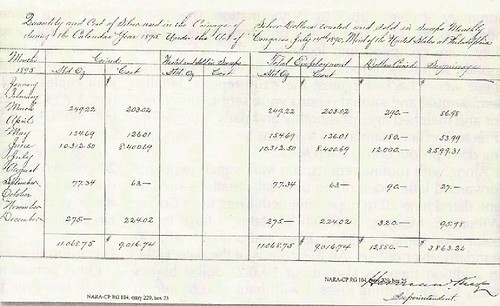
The article includes a very clear image of the monthly summary page (retrieved from the National Archives) that shows the coins produced at the Philadelphia Mint in 1895, including 12,880 silver dollars. The dollars were produced in March (290), May (180), June (12,000), September (90) and December (320).
Mr. Burdette then discusses the role of the Assay Commission that met on February 14, 1896 to examine the coinage of 1895. He reports that the Commission examined ten 1895 silver dollars at that meeting (from the March, May, June, September and December deliveries).
For those who are not aware, Mr. Burdette has retrieved and made available the records of the annual Assay Commission from 1800 to 1943. They are available as a 4-DVD set from Wizard Coin Supply.
To my mind, unless one wishes to advocate for a fairly complex chain of cover-ups, Mr. Burdette makes a very convincing argument that 12,880 silver dollars were produced in 1895, at least 12,000 of them were placed into storage and, most likely, melted during the 1918 Pittman melt.
Of course, this summary of Mr. Burdette’s article is brief and incomplete and intended to encourage those who are interested to seek out and read the complete article, which should be more widely known than it apparently is.
Mr. Burdette also introduces a very interesting wrinkle: the 1895-dated silver dollar dies that were available to strike the coins. He reports that no silver dollar dies were produced for circulation-strike coins, but that five obverse and four reverse dies were produced for Proof coinage.
At this, those interested in searching for any of the 12,000 “circulation-strike” coins must want to pull out their hair. We know that Proof coins of the time were struck on the Mint’s medal press under greater-than-normal striking pressure, using polished dies and carefully selected and prepared planchets. Presumably, the 12,000 1895 circulation strike coins were struck on a production press, but did the Mint use new dies or dies that had already struck Proof coins? If the dies were different, had they been polished? If one could have told the difference between a Proof coin and a circulation strike coin struck by the same dies immediately after the coins had been manufactured, would one still be able to distinguish the two after some circulation?
At this point, I will leave it to the Morgan Dollar specialists to answer these questions!
To read the earlier E-Sylum article, see:
THE PHANTOM SILVER DOLLARS OF 1895
(www.coinbooks.org/esylum_v18n16a30.html)
To read Tom's complete article, see:
The Phantom Dollars Of 1895
(www.hjbltd.com/departments/articles/details.asp?inventorynumber=57&linenum=25)
To order Burdette's Assay Commission DVD, see:
Annual Assay Commission: United
States Mint 1800-1943 (www.wizardcoinsupply.com/annual-assay-commission-united-states-mint-1800-1943.html)
THE BOOK BAZARRE
OFF-CENTER 1921-D MORGAN DOLLAR
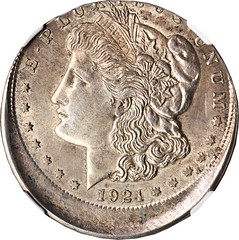
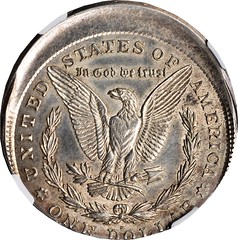
1921-D Morgan Silver Dollar--Struck 10% Off Center--AU-58 (NGC).
While it might take a great deal to excite the typical collector over a 1921 Morgan dollar, this coin is exactly one of those rare
occurrences! Off center Morgan dollars are all scarce and all very desirable, and many are dated 1921. However, almost none are from the
Denver Mint, which struck this issue only in 1921. In fact, it is believed that just two or three such coins might be known, according to
the book 100 Greatest U.S. Error Coins, by Nicholas P. Brown, David J. Camire and Fred Weinberg.
Off center Morgans make two appearances in that book, first at #22, for a 40% off center 1880-S, considered the finest such Morgan dollar error, and secondly at #23, for a widely off center 1921-S. There are believed to be 15 to 20 examples of the 1921-S known, whereas, again, the estimate for the 1921-D offered here is just a couple of coins! Pleasing light silver gray with some areas of deeper toning. Minor handling, likely from showing it off as a curiosity (or "freak" as such pieces were referred to in numismatic circles when this was struck), but good luster remains. A great error coin and among the highlights of the present offering.
To read the complete lot description, see:
1921-D Morgan Silver
Dollar--Struck 10% Off Center--AU-58 (NGC). (http://www.stacksbowers.com/BrowseAuctions/LotDetail/
tabid/227/AuctionID/6099/Lot/24257/Default.aspx)
HARVEY STACK RECALLS SHAPIRO, KAGIN AND STEINBERG
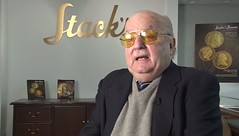 In this mini-series of interviews, Harvey Stack shares his thoughts and recollections about some of his
friends and rivals in numismatics.
In this mini-series of interviews, Harvey Stack shares his thoughts and recollections about some of his
friends and rivals in numismatics.
To read the complete article, see:
Harvey
Stack – Recollections of Jonah Shapiro, Art Kagin and William “Foxie” Steinberg
(www.coinweek.com/video-news/new-videos/harvey-stack-recollections-of-jonah-shapiro-art-kagin-and-william-foxie-steinberg/)
THE ORIGINAL MONTROVILLE DICKESON PHOTO


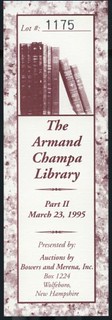 As promised, I am sending you the attached “bi-chromate” image of "Montroville W.
Dickeson, which was lot 1175 in Part II of The Armand Champa Library sale of March 23, 1995, which I purchased at the sale. I attach the
auction ticket and lot description, together with an image of the Robert Wester letter stating that “This photograph was laid in an 1859
copy of Dr. Montroville W. Dickeson’s American Numismatical Manual which belonged to the noted Pharmacist-Numismatist Robert Coulton Davis
of Philadelphia, Pa.”
As promised, I am sending you the attached “bi-chromate” image of "Montroville W.
Dickeson, which was lot 1175 in Part II of The Armand Champa Library sale of March 23, 1995, which I purchased at the sale. I attach the
auction ticket and lot description, together with an image of the Robert Wester letter stating that “This photograph was laid in an 1859
copy of Dr. Montroville W. Dickeson’s American Numismatical Manual which belonged to the noted Pharmacist-Numismatist Robert Coulton Davis
of Philadelphia, Pa.”
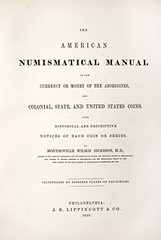 The engraved portrait of Dickeson is from the 1859 edition of his work, The American
Numismatical Manual of the Currency or Money of the Aborigines, Colonial, State and United States Coins. You’ve run this image
previously as part of Pete Smith’s 2011 submission to The E-Sylum concerning Dickeson, (Volume 14, Number 45, October 30, 2011,
Article 11.)
The engraved portrait of Dickeson is from the 1859 edition of his work, The American
Numismatical Manual of the Currency or Money of the Aborigines, Colonial, State and United States Coins. You’ve run this image
previously as part of Pete Smith’s 2011 submission to The E-Sylum concerning Dickeson, (Volume 14, Number 45, October 30, 2011,
Article 11.)
After reading recent issues of The E-Sylum, and looking at the earlier 1859 engraving and the one in Volume 18, Number 13, March 29, 2015, Article 10, in my opinion the hairline of Dickeson does not match that of the gentleman photographed with the Native American.

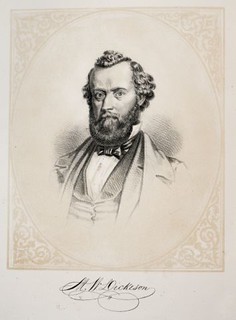
I wonder if Bob Wester’s account was correct, and Robert Coulton Davis really put the photo in his copy of Dickeson’s book, as the Wester letter would seem to indicate? Note that this letter by Wester which accompanied the photo in the Champa library sale, differs a bit in description of the Wester attribution by brother Joel Orosz, who reports that “In my library I have a print of that very picture made years ago by Bob Wester. It was prepared by Bob Wester in February of 1984. Notes on the back suggest that Wester found the original print of this photo laid in to a copy of the New York Stamp and Coin sale of the Robert Coulton Davis collection (1890).” (The E-Sylum: Volume 18, Number 13, March 29, 2015, Article 10,)
Although I bought the photo as an early image of an influential, if controversial American numismatist, who published one of the earliest guidebooks of American coinage, I find the "Montroville W. Dickeson"/Perrin Whitman photograph is historic and interesting, if a bit of a mystery.
To read the earlier E-Sylum articles, see:
MONTROVILLE WILSON DICKESON (www.coinbooks.org/esylum_v14n45a11.html)
MORE ON MONTROVILLE DICKESON (www.coinbooks.org/esylum_v15n30a07.html)
QUERY: IS IT REALLY MONTROVILLE DICKESON IN THIS PHOTO?
(www.coinbooks.org/esylum_v18n13a10.html)
MORE ON THE MONTROVILLE DICKESON PHOTO
(www.coinbooks.org/esylum_v18n14a11.html)
READER TAKES ON BANKNOTE DESIGN
Women on U.S. Banknotes
Ralph Langham writes:
We already had a woman on U.S. paper money - one of my favorite notes and that would be Martha Washington - then Liberty on the Fractional notes.
Something We Can All Agree On
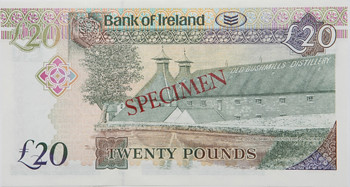
Bushmills Distillery on the Bank of Ireland 20 pound note
David Powell writes:
I have just returned on Saturday from my first-ever holiday in Northern Ireland. The argument over whether to put men or women on banknotes is very simple; any person considered, of either sex, would invariably be either Protestant or Catholic, which would offend at least some of the people in the other community big time.
The Bank of Ireland seems to have resolved this by deciding that, since the only thing which Protestants and Catholics appear to have in common is their love of alcohol, a picture of one of their best known distilleries {Bushmills} is the safest choice for use on all their most commonly used denominations.
For more information on the banknotes, see:
Bank Notes
(https://boini.bankofireland.com/about-boi-group/bank-notes/)
Criteria for Deciding Who to Honor on Banknotes

The most successful group of non-sexist banknotes, in my opinion, was the "Personality Series" issued by the Deutsche Bundesbank in 1990-2001. It consisted of 8 notes, ranging from 5 Deutschemark to 1000 Deutschemark, with 4 notes with female personalities and 4 notes with male personalities, although boys still beat girls by one because the Brothers Grimm both appeared on the 1000 DM note (so the notes depicted five men and four women). Not only did the series have gender balance, it also was balanced by religion, with three Roman Catholics, three Lutherans, one Jew (Paul Ehrlich) and two Reformed (Calvinist) (the Brothers Grimm).
Because of Germany's tumultuous history, politicians and military leaders were out of the question - Bismarck and Erich Ludendorff certainly had great ability, but they would be unacceptable on a modern German banknote - and so individuals were chosen from art, literature, music, business, science and technology. In the end no businessperson, and no one from technology, ended up being chosen.
It was also decided not to include any super personalities - so no Goethe, no Schiller, and no Duerer. (This may have also been because East Germany already had a Goethe note.) The series also tried to have as many different occupations as possible, although it ended up with two poets (Arnim and Droste-Huelshoff). The choices were excellent: Bettina von Arnim, Carl Friedrich Gauss, Annette von Droste-Huelshoff, Balthasar Neumann, Clara Schumann, Paul Ehrlich, Maria Sibylla Merian and the Brothers Grimm.
The notes tell a history that ranges from baroque architecture (Neumann) to the cure of syphilis (Ehrlich) to a pioneer of entomology (Merian). The DM 10 note, with Gauss, depicts both triangulation and a bell curve. The notes presented German culture and civilization in the best light possible. The only problem is that they circulated for too short a time, a little over a decade, after which the boring Euro notes replaced them.
The United States would do well to follow this approach. Eliminating politicians and military figures is a good start - they carry a lot of negative baggage. I like the idea of leaving out the super figures - so Mark Twain, Walt Whitman, Elvis Presley, Humphrey Bogart, Marilyn Monroe, Ernest Hemingway and Frank Sinatra are hors concours.
I decided on eight notes (adding a $200 note); the male female split would be 4 and 4; there would be two African-American notes, and one apiece representing Asian Americans, Latino Americans, and Native Americans. Just as in the German notes, male and female notes alternate as the denominations progress, and there is diversity among occupations. I violate my ban on politicians once to let in Wilma Mankiller. So here's my proposal: $1 Cesar Chavez; $2 Wilma Mankiller; $5 Scott Joplin; $10 Mary Cassatt; $20 Frank Lloyd Wright; $50 Marian Anderson; $100 An Wang; $200 Emily Dickinson.
As an alternative, a series of notes of American painters (with a depiction of the painter on the front, and an example of the painter's work on the reverse) would result in very attractive multicolor notes. It would advertise the United States of America not for its military might, nor for its economic wealth, but for its contribution to culture. For this series I propose: $1 John Singleton Copley; $2 Mary Cassatt; $5 Thomas Cole; $10 Georgia O'Keeffe; $20 Winslow Homer; $50 Helen Frankenthaler; $100 Jackson Pollock; $200 Lee Krasner. I think a Jackson Pollock note would be a knockout.
For more information on the notes, see this Wikipedia article (in German), see:
Cash Deutsche Mark
(de.wikipedia.org/wiki/Bargeld_der_Deutschen_Mark#
Abbildungen_und_Abmessungen_3)
To read the earlier E-Sylum article, see:
DICK JOHNSON'S TAKE ON WOMEN ON MONEY
(www.coinbooks.org/esylum_v18n16a29.html)
THE POLISH 20 PLN NOTE BY ANDRZEJ HEINDRICH
Gosia Fort writes:
The Polish 20 PLN note with Marshal Józef Pilsudski's image commemorating the 100th anniversary of forming Polish Legions was honored with the “Banknote of the Year Award” during the High Security Printing conference held in Budapest last month. The artist, Andrzej Heindrich, based its design on his earlier project from the early 90-ties meant for the 5,000,000 note. However, though ready this note never made to circulation, because of the denomination process in Poland which started in January 1995. The 20 PLN note combines the classic design and the newest technology. It is the first polymer (not paper) based money in Poland.
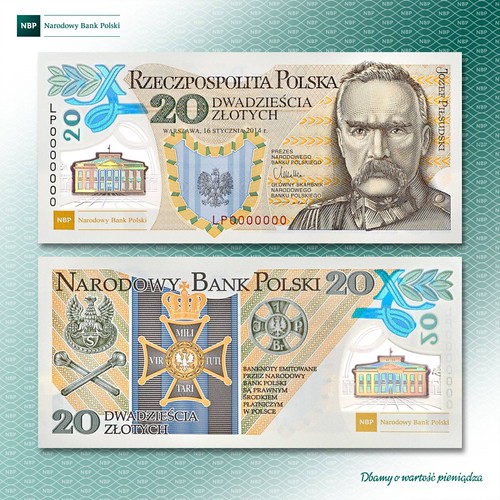
To read the complete article, see:
Prestiżowa nagroda dla polimerowego banknotu z
Józefem Piłsudskim (www.nbp.pl/home.aspx?f=/aktualnosci/wiadomosci_2015/20150327_jp.html)
THE BOOK BAZARRE
1874 TREATY 4 MEDAL ON DISPLAY
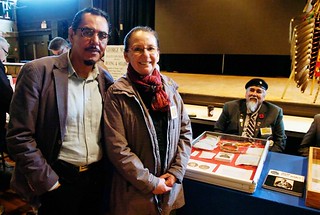 Ray McCallum doesn't see himself as the owner of a rare medal.
Ray McCallum doesn't see himself as the owner of a rare medal.
The medal, which was given to the chiefs who signed Treaty 4 in 1874, was bought by McCallum and his wife, Paula Acoose, last year.
"It's not our medal. It belongs to the people," said Mc-Callum. "The people's medal is all the people of Treaty 4 and Saskatchewan."
That's why McCallum and Acoose weren't shy about having the medal on display at a Regina Coin Club show, which was hosted at the Turvey Centre on the weekend. After buying it at an auction for $40,000 last year, Mc-Callum and Acoose briefly kept the medal in their home before placing it in a safety deposit box at a bank. Since April, it has been stored at the Royal Saskatchewan Museum.
"People have been expressing interest and asking about the medal, and what we've found is it's a very big responsibility," said Acoose.
She said many people have asked about borrowing the medal to put on display. The couple is hoping to set up an advisory board in the future to help manage the medal.
"It's so very important (to have on display), not only for the older people like us, but particularly the younger people," Acoose said.
About 500 people were expected to see the medal over the weekend. Several coin collectors and enthusiasts were at the Regina Coin Club's show on Saturday morning.
George Manz, president of the coin club, said he contacted McCallum and Acoose shortly after the medal was purchased to ask about putting it on display.
It's believed only 21 of the medals were made and fewer than that still exist.
"To me, it's priceless," said Manz. "Almost no one has ever seen one before."
To read the complete article, see:
Medal garnering interest
(www.leaderpost.com/news/Medal+garnering+interest/10986791/story.html)
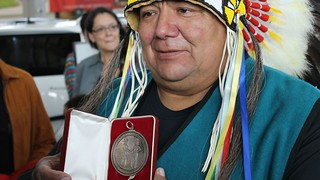 After
mysteriously disappearing for generations, the only Treaty 4 medal to be found has returned home to Saskatchewan.
After
mysteriously disappearing for generations, the only Treaty 4 medal to be found has returned home to Saskatchewan.
The Government of Canada handed out 21 of these medals to First Nations chiefs who signed the treaty for the area covering southern Saskatchewan in 1874.
This particular medal suddenly resurfaced at an auction in London, Ont. and Paula Acoose and her husband Ray McCallum soon found themselves in a bidding war, one of a series of lucky events leading to the medal returning home.
"Going once, going twice, sold for $40,000, and that's how we got it. We left the room about five minutes after that and cried and hugged each other in the hallway," said Acoose.
They spent $40,000 dollars out of their own pockets. That may sound like a lot of money for a medal, but to the First Nations in southern Saskatchewan, it's priceless.
"Out of all of the ones that were given out at the original treaty signings, this is apparently the only one still known to exist," said Royce Pettyjohn.
Pettyjohn is a volunteer at a museum in Maple Creek. He has done extensive research on the Treaty 4 medals and this one wouldn't have returned to its rightful owners if he didn't spot the medal in the auction catalog.
"I knew right away that it was of tremendous historical significance as well as great spiritual significance for the First Nations people," he explained.
The medal was discovered in the estate of a man named Robert D.W. Band. There were no documents with it or any sign of where it's been all these years, or how Band inherited it.
Watching such a rare piece flow through her auction house, Wendy Hoare, from Jeffrey Hoare Auctions, decided to personally deliver it to the Treaty 4 First Nations. She hopped on a flight to Regina on Monday evening and presented the medal to First Nations members in a similar fashion as it was in 1874.
"Safely, from my hands to their hands," she said.
"Our prayers were answered, and when I touched it - very emotional," said Noel Starblanket while holding the medal his great, great-grandfather once held.
To read the complete article, see:
PHOTOS: Treaty 4 medal from 1874 returned to SK
(http://panow.com/article/475551/photos-treaty-4-medal-1874-returned-sk)
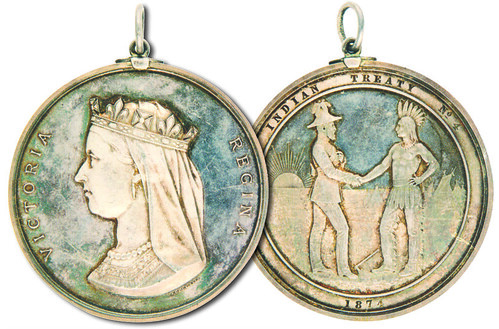
To read the complete article, see:
Rare treaty medal finds way back to Native hands
(http://canadiancoinnews.com/rare-treaty-medal-finds-way-back-native-hands/)
THE COLLECTOR OF MEDALS BY DANIEL DUPUIS


Gawain O'Connor writes:
There are a lot of interesting things on eBay, but here is a numismatic medal I thought to bring to the attention of your E-Sylum readers a "Fabulous French Bronze medal / Numismatist / by DANIEL - DUPUIS"
It is inscribed to Jean Mazard who was the author of Histoire monétaire et numismatique contemporaine, 1790-1963, the main reference on modern French coins (before Victor Gadoury published his). Mazard is the primary source cited for patterns and essais even today. His other work was Corpus Nummorum Numidiae Mauretaniaeque.
Art Nouveau extremely rare French Bronze plaque by DANIEL - DUPUIS with original Box
The Collector of Medals symbolized by a naked woman admiring medals with a magnifying glass
Awarded to : " AU NUMISMATE JEAN MAZARD SON VIEIL AMI MICHEL AVERBUCH "
Engraver : Jean - Baptiste DANIEL - DUPUIS (1849 - 1899) French sculptor and medallist, pupil of Hubert Ponscarme and Eugène Farochon. He won in 1872 the First " Grand Prix de Rome " and the Gold Medal of the Paris 1889 Universal Exhibition
Dimensions : 60 mm x 39 mm = 2,4 inches x 1,56 inch
Weight (gr) : 74 grs / with the box : 114 grs
Edge : engraving " BRONZE " and the hallmark " Cornucopia ( Horn of Plenty Paris Mint ) "
I'm not familiar with Michel Averbuch, but would be impressed to have such a great "old friend" who presented me with a medal such as this.
Disclaimer - I'm not associated with this item other than being its admirer. Ooh - just found his bookplate on eBay's French site :
To read the complete eBay lot descriptions, see:
Fabulous French Bronze medal / Numismatist / by DANIEL - DUPUIS / original Box
(www.ebay.com/itm/231539831456)
EX-LIBRIS de Jean MAZARD
(www.ebay.fr/itm/EX-LIBRIS-de-Jean-MAZARD-/141622014513)
QUERY: JENNY LIND MEDAL OVERSTRUCK ON MEXICAN 2R

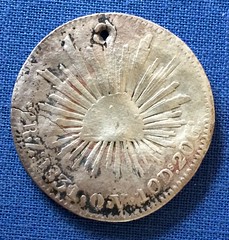
Ralf Böpple of Stuttgart / Germany writes:
An eBay find: an 1831 Mexican two bits overstruck with the bust of Jenny Lind. I could not find much on Jenny Lind medals, and as far as I remember leafing through the ANS Numismatic Notes publication on her medals a good while back, it's not in there.
Is this a newer creation, or is this actually contemporary to the 1850 tour of the U.S. of the "Swedish Nightingale"? I was wondering whether any E-Sylum reader might have additional information, as this is not my field of specialty (I came across it due to the host coin).
To read the complete eBay lot description, see:
OVERSTRUCK JENNY LIND MEDAL. Struck on an 1871 Mexico 2 Reales.
MESZAROS DESIGN WINS AMERICAN MEDAL OF THE YEAR
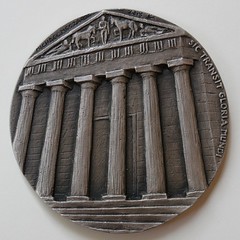

While it took 132 years for an Australian yacht to win the America’s Cup, an Australian medalist has managed to win in the first year of the American Medal of the Year (AMY) competition sponsored by the American Medallic Sculpture Association. Out of 29 medals entered, only two were not created by Americans— and one of those won--Sic Transit Gloria Mundi (Thus passes the glory of the world) by the venerable Australian medalist Michael Meszaros.
Michael Meszaros indicates that “My thoughts leading to this design were prompted by the arrogance if so many of today's leaders and politicians combined with a visit to Rome in October 2013. With my wife, we spent a lot of time wandering around the forums and other ruins. I had become familiar with them originally in 1969 when I spent seven months there studying at La Scuola dell'Arte della Medaglia. Having studied architecture in Melbourne, I am familiar with how many regimes over the centuries have tried to cement their political futures with overblown neoclassical architecture. Most of them have collapsed or are much reduced. All these thoughts combined to the design where the ambitious building is on one side and the eventual demise is on the other. I have always liked the idea of a double sided medal with a time lapse between the sides and it seemed to all fall together. Using the Romans own saying for the title shows that even they realized that nothing is forever.”
Michael Meszaros medals are held by Museum Victoria, the British Museum, the Royal Dutch Coin Collection, and many private collections in Europe, America, Australia, New Zealand and the United Kingdom. In August 2011 he was awarded the American Numismatic Association's “Numismatic Art Award for Excellence in Medallic Sculpture,” and in 2012 he received an OAM (Medal of the Order of Australia) in the Queen's Birthday Honors.
Nominations for the American Medal of the Year were invited from medalists, mints, jurors, AMSA members, or anyone else by March 1, 2015 for the preceding calendar year. Meszaros was able to enter as an AMSA member. Later this year, he will be presented with the AMY Award, designed by Heidi Wastweet,.
The seven distinguished jurors are: Philip Attwood, Curator of Medals, Department of Coins and Medals, British Museum and editor of Medals; Cory Gillilland, Member of the Consultative Committee of Fédération Internationale de la Médaille d'Art and formerly Curator and Deputy Director of the National Numismatic Collection at the Smithsonian Institution; Barbara Gregory, editor of The Numismatist; Arthur Houghton, former curator of antiquities at the J. Paul Getty Museum and president of the American Numismatic Society; Steve Roach, editor of Coin World, and formerly paintings specialist at Christie's; Dr. Alan Stahl, Curator of Numismatics, Princeton University, and one of the founders of AMSA; and Dr. Benjamin Weiss, medal collector and author, member of the board of directors of Medal Collectors of America and its webmaster.
The voting was very close, with one juror having to break a 3-3 tie. The runner-up was Invisible Reconnoiter I by the prominent American medalist Mashiko.
It was the hope of the AMSA Board that an annual American Medal of the Year would inspire the members of AMSA in particular and all American medalists in general to create more art medals. Mel Wacks, chair of the AMY Planning Committee, indicated that “The high quality of the first year’s entries bodes well for the future of the competition and for medallic art.”
The American Medallic Sculpture Association invites American and world medalists to join, as well as art medal collectors. The AMSA newsletter publishes news of workshops and exhibits, and illustrates noteworthy art medals produced by members and others both in the United States and overseas. Dues of $40, U.S. and Canada, or $50 elsewhere can be sent to AMSA, P.O. Box 1201, Edmonds, WA 98020. Their website is www.amsamedals.org.
MICHAEL ALEXANDER VISITS FRANKFURT’S HISTORICAL MUSEUM
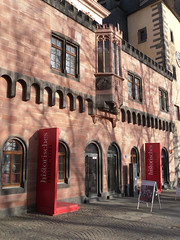 Frankfurt, with its long and noteworthy history as a city of finance and commerce stretching back to
the times of Charlemagne, has continued that tradition through two occasions of German unification & reconstruction after two world wars.
And, of course aside from being the seat of the German Stock Exchange, the DAX, this extraordinary city was named the home of the Deutsche
Bundesbank in 1957 and the European Central Bank with the advent of the EU’s single currency, the Euro.
Frankfurt, with its long and noteworthy history as a city of finance and commerce stretching back to
the times of Charlemagne, has continued that tradition through two occasions of German unification & reconstruction after two world wars.
And, of course aside from being the seat of the German Stock Exchange, the DAX, this extraordinary city was named the home of the Deutsche
Bundesbank in 1957 and the European Central Bank with the advent of the EU’s single currency, the Euro.
Although the city has played a remarkable part in the financial life of Germany and even that of Northern Europe, there is also another side to this Free City, as it was once known. The Frankfurt Historical Museum (FHM) includes many artifacts which chronicle not only the annals of the development of Frankfurt literally over the centuries but also that of Germany itself. Of particular interest to a “numisma-tourist” like myself are the amazing collections of coins on display and the span of time they represent. What’s even more exciting about the FHM is that they are undergoing an extraordinary transformation which when completed in two years, will significantly increase the exhibition space and enable the Museum to showcase so much more than is currently on display at present.
Currently, the coin collection is displayed over several floors and divided into key sections which includes Egyptian, medieval, Empire & modern and exhibited in cases and drawers which allow for ease of viewing. There is also an interactive section which highlights those more noteworthy benefactors to the Museum and whose collections of coins are now featured.
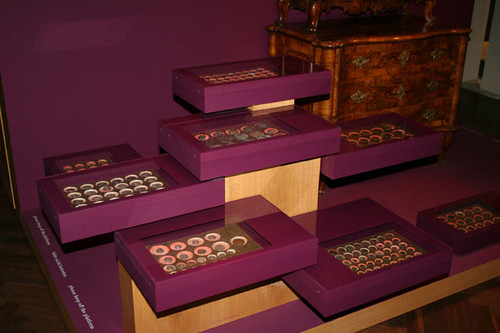
Benefactors, Heinrich Bernhard (1691-1752) & Catharina Elisabeth (1696-1749) von Barckhaus, both passionate coin collectors whose collection of Greek & Roman ancient coins as well as the wooden cabinet which housed their collection is now part of the collection of the Historical Museum.
To read the complete article, see:
Numismatic Treasures on
Display at the Frankfurt Historical Museum
(http://news.coinupdate.com/numismatic-treasures-on-display-at-the-frankfurt-historical-museum-4799/)

SHIPS ON ANCIENT COINS
Greeks
 BY THE SIXTH CENTURY BCE, when coinage came into wide use in the Mediterranean world, ships had evolved to a high technical level. Most
ships on ancient coins are rowing galleys: big, fragile racing shells designed for ramming. Rowers were free citizens, often highly trained
athletes. Hollywood, as usual with history, gets it wrong; galley slaves were a medieval innovation rarely employed in the ancient world.
Cargo ships, which relied more on sails, were not symbols of power and appear on coins less often.
BY THE SIXTH CENTURY BCE, when coinage came into wide use in the Mediterranean world, ships had evolved to a high technical level. Most
ships on ancient coins are rowing galleys: big, fragile racing shells designed for ramming. Rowers were free citizens, often highly trained
athletes. Hollywood, as usual with history, gets it wrong; galley slaves were a medieval innovation rarely employed in the ancient world.
Cargo ships, which relied more on sails, were not symbols of power and appear on coins less often.
Considering the importance of maritime trade and conflict in ancient Greece, it is surprising how few ships appear on archaic (before 500 BCE) and classical (500 – 336 BCE) Greek coins. We hardly ever see a whole ship, usually only the prow (the bow section, with the ram) or the stern (where the steersman sat).
Mariners are famously superstitious–was it bad luck to depict an entire ship? Probably not, since vase paintings of this era often show complete vessels. More likely it was simply too difficult for die cutters to engrave so many oars. Even a small warship (the pentekonter) had 25 oars per side, while the standard war vessel (the trireme) had 85 oars per side, packed in three tiers.
Phoenicians
Beginning in the fifth century BCE, the main coin-issuing Phoenician cities were Tyre (Sur), Sidon (Saida), Byblos (Jubail) and Arados (Arwad).
Phoenician coins often represent waves of the sea abstractly as a series of zigzag lines, but ships are shown in considerable detail, with the round shields of warriors arrayed along the railing. A half-shekel of Sidon shows the sail “reefed” up to the yardarm, hanging in loose folds.
 Carthage, founded as a colony of Tyre around 800 BCE, eventually challenged Rome for dominance of the
Mediterranean. One of the few Carthaginian coins to show a ship was struck for Hamilcar Barca (father of Hannibal) at Cadiz in Spain (c.
237-209 BCE). On this rare silver shekel, a dolphin swims alongside the prow, a sight still familiar to mariners.
Carthage, founded as a colony of Tyre around 800 BCE, eventually challenged Rome for dominance of the
Mediterranean. One of the few Carthaginian coins to show a ship was struck for Hamilcar Barca (father of Hannibal) at Cadiz in Spain (c.
237-209 BCE). On this rare silver shekel, a dolphin swims alongside the prow, a sight still familiar to mariners.
Romans
Some of the most common and affordable Roman silver coins depicting a ship are the “Legionary” issues struck to pay the army of Mark Antony during the civil war in 32 BCE. These coins honor 23 numbered legions and two elite units, the Praetorian Cohorts (the commander’s bodyguard) and the Speculatores (who served as scouts).
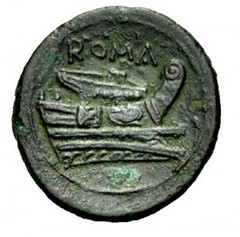 The generic warship shown on the obverse has from seven to 14 oars – evidently this was left to the discretion and patience of the die
cutter. Struck in debased silver, these coins remained in circulation, at a discount, for decades after Antony’s defeat and death. Most
examples are well-worn and punched with banker’s marks. The inscription ANT AUG hails Antony as augur, a priest of the Roman state religion
(the title Augustus came into use years later). III VIR RPC abbreviates another title, “Triumvir for the Restoration of the Republic.”
Collectable examples typically sell for US$200-400, with rare types, like the Cohortis Speculatorum, going for over $2000 in high
grade.
The generic warship shown on the obverse has from seven to 14 oars – evidently this was left to the discretion and patience of the die
cutter. Struck in debased silver, these coins remained in circulation, at a discount, for decades after Antony’s defeat and death. Most
examples are well-worn and punched with banker’s marks. The inscription ANT AUG hails Antony as augur, a priest of the Roman state religion
(the title Augustus came into use years later). III VIR RPC abbreviates another title, “Triumvir for the Restoration of the Republic.”
Collectable examples typically sell for US$200-400, with rare types, like the Cohortis Speculatorum, going for over $2000 in high
grade.
To read the complete article, see:
Ships on Ancient Coins
(www.coinweek.com/ancient-coins/ships-on-ancient-coins/)
SELECTIONS FROM THE SLANEY COLLECTION OF ENGLISH COINS
Lot 349: Carlisle Siege Coin
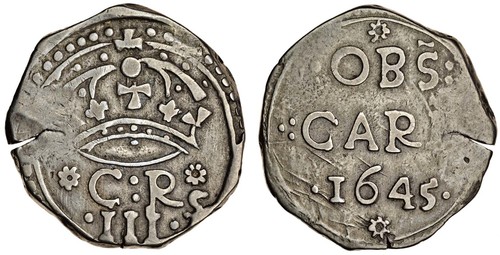
Charles I (1625-49), Carlisle besieged (October 1644 - June 1645), Three-Shillings, 15.45g, 1645, large crown over c:r dividing rosettes (anemone) and .iii.s below, rev. .:obs:. .:carl:. 1645 in three lines with rosette (anemone) above and below (Nelson 1; N.2633; S.3137), edge split at 9 o'clock, otherwise unusually well struck for this coin, deeply toned, good very fine, extremely rare
provenance
R C Lockett, part IV (English part II), Glendining, 11-17 October 1956, lot 2565, £155
H W Thorburn, Sotheby, 27-29 November 1918, lot 258, £17
H Montagu, third portion, Sotheby, 13-19 November 1896, lot 633, £8
W Brice, collection purchased by H Montagu in1887
J B Bergne, Sotheby, 20 May 1873, lot 781, 'fine and extra rare', £6.15/-
In the Lockett catalogue this piece is described as 'very fine and well struck for this extremely rare coin'. In the Spink library copy 'very fine' is crossed out and 'extremely fine for this' is written in its place.
To read the complete lot description, see:
www.spink.com/lot-description.aspx?id=15031000349
Lot 359: Scarborough Siege Coin
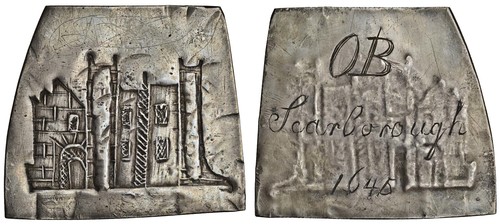
Charles I (1625-49), Scarborough besieged July 1644 - July 1645, type 1, siege piece of 10.01g, probably Two-Shillings, view of the castle, sc and mark of value (?) s very faint below, rev. the same faintly incuse, also engraved at a later date OB. Scarborough 1645 (Nelson pp.17-19 and fig.21 this coin; N.2650 b; S.3152), light scratches above castle, extremely fine, extremely rare
provenance
Lockett, part IV (English part II), Glendining, 11-17 October 1956, lot 2575, denomination not stated, £460
V Brand, collection dispersed after 1932
J G Murdoch, second portion, Sotheby, 8-13 June 1903, lot 358, as a Two-Shillings (illustrated), 'extremely fine, unpublished and
probably unique', £44.10/-
H Montagu, third portion, Sotheby, 13-19 November 1896, lot 655, £36.10/-
W Brice, collection purchased en bloc by H Montagu in 1887
E W Wigan, collection purchased by Rollin & Feuardent in 1872
To read the complete lot description, see:
www.spink.com/lot-description.aspx?id=15031000359
Lot 365: Cromwell Pattern Twenty Shillings
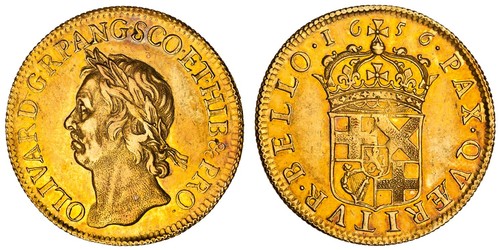
Cromwell (Protector 1653-58), pattern Broad of Twenty Shillings, 1656, olivar d.g. rp. ang. sco. et. hib & pro., laureate head left, rev. inverted die axis, pax. qvaeritvr. bello., crowned shield, date above, edge vertically milled (N.2744; Schneider 367; S.3225; WR 39), very fine, scarce
provenance
Purchased from Baldwin, 1945, £35
To read the complete lot description, see:
www.spink.com/lot-description.aspx?id=15031000365
Lot 495: 1732 George II Proof Crown
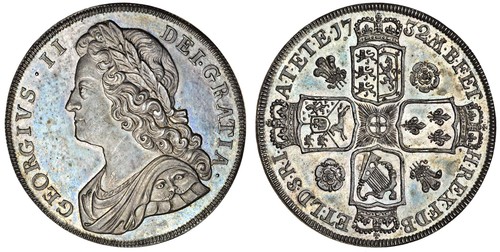
George II (1727-60), proof Crown, 1732, obverse by J Croker, reverse by J Tanner, georgivs. ii dei. gratia., young, laureate and draped bust left, rev. inverted die axis, m.b.f.et. h.rex.f.d.b. et.l.d.s.r.i. a.t.et.e., four crowned shields cruciform, roses and plumes in angles, ten strings to Irish harp, Garter Star in centre, edge plain (ESC 118 - R3; L&S 6; S.3686), a splendid coin, almost uncirculated, light toning and with much lustre, very rare
provenance
H M Lingford, Glendining, 24-26 October 1950, lot 444, 'in brilliant state and prettily toned, very rare', £39
To read the complete lot description, see:
www.spink.com/lot-description.aspx?id=15031000495
THE COLLECTION OF ALEXANDRE CARATHÉODORY PASHA
 One the highlights of CNG 99, an Internet and Mail Bid Sale closing on May 13, 2015, is a
selection of coinage from the collection of Alexandre Carathéodory Pasha, a leading statesman in the Ottoman Empire, whose interest in
collecting ancient coins was inspired by his meeting with the French diplomat and numismatist William-Henri Waddington at the Congress of
Berlin in 1878. Twenty Greek coins of the Eastern Aegean and Western Asia Minor are being offered in CNG 99, and the majority of the
collection is being offered in CNG Electronic Auction 351, which runs concurrently with CNG 99 and closes on 20 May 2015.
One the highlights of CNG 99, an Internet and Mail Bid Sale closing on May 13, 2015, is a
selection of coinage from the collection of Alexandre Carathéodory Pasha, a leading statesman in the Ottoman Empire, whose interest in
collecting ancient coins was inspired by his meeting with the French diplomat and numismatist William-Henri Waddington at the Congress of
Berlin in 1878. Twenty Greek coins of the Eastern Aegean and Western Asia Minor are being offered in CNG 99, and the majority of the
collection is being offered in CNG Electronic Auction 351, which runs concurrently with CNG 99 and closes on 20 May 2015.
Alexandre Carathéodory Pasha (or Karatheodory; in Greek: Αλέξανδρος Καραθεοδωρή; 1833–1906) was a prominent Greek scholar, diplomat, and statesman in the Ottoman Empire. Carathéodory was born in Constantinople to an eminent Constantinople Phanariot family. His father, Stefanos Carathéodory, was the personal physician to Sultans Mahmud II and Abdul-Aziz. His mother’s ancestors, the Mavrocordatos and Mourousis, had for centuries served as Princes of Moldavia and Wallachia.
After obtaining a doctoral degree from the Paris Faculty of Law, Carathéodory pursued a career in the public service of the Ottoman Empire. In 1874, he was appointed ambassador to Rome. In 1878, as Vice Minister of Foreign Affairs, he participated in the preliminary negotiations with Russia that led to the Treaty of San Stefano, ending the Russo-Turkish War (1877-1878). Later that same year, Sultan Abdul-Hamid II dispatched Carathéodory to Germany as head of the Ottoman delegation to the Congress of Berlin. His skillful negotiations with various European statesmen, including Bismarck, Disraeli, Salisbury, and Gorchakov, resulted in the revision of the San Stefano peace terms in favor of the Ottoman Empire (Treaty of Berlin, 1878). Disraeli characterized Carathéodory as “full of finesse and yet calm and plausible.” During the Berlin negotiations, he had the opportunity to discover in his French counterpart, William-Henri Waddington, a common interest in ancient Greek culture and civilization. Waddington told Carathéodory of his archaeological pursuits and the collection of ancient coins he had assembled in Asia Minor.
Upon his return to Turkey, Carathéodory was appointed Governor-General of Crete with the task of calming the escalating tensions between the island’s Christian and Muslim inhabitants in a situation that was approaching civil war. Soon, however, he was called back to Constantinople, where he became Minister of Foreign Affairs of the Ottoman Empire (1878-1879). He was the only Greek to ever occupy such a prominent position. In 1884, the Sultan appointed him Prince of the autonomous Greek island of Samos (1885-1894). It is during those nine years, and inspired by Waddington’s enthusiasm for ancient coins, that he took up coin collecting and assembled the present collection.
In addition to his political career and historical pursuits, Carathéodory translated from Arabic to French the Traité du Quadrilatère, attribué à Nassiruddin-El-Tussin, a seminal work on the mathematics of the 13th-century Persian astronomer. He also authored research papers and scholarly essays on Aristotle’s Meteorology, Homeric studies, as well as a series of mathematics theses that are still in use. Their shared interest in mathematics forged a bond with his nephew, Constantine Carathéodory, a professor of mathematics at the University of Munich, who contributed to the research of thermodynamics and the development of Albert Einstein’s theory of relativity (vide Encyclopaedia Britannica).
In 1895, amid renewed religious and social tensions in Crete, Abdul Hamid II appointed Carathéodory as Governor of the island for a second time. Unsuccessful once again in restoring order, Carathéodory resigned the post in December of the same year and was appointed First Translator to H.I.M. the Sultan. In his book, Constantinople, City of the World’s Desire, Philip Mansel notes that Abdul Hamid called Carathéodory “a man with remarkable ability, not only the cleverest diplomat in Turkey, but one of the cleverest in Europe.” In 1901, Carathéodory attended the funeral of Queen Victoria as a member of the Ottoman delegation. This was his last official assignment.
His funeral in 1906, in Constantinople, was officiated by the Patriarch and all the Holy Synod. It marked, according to Mansel, the end of the Phanariot tradition begun by his Mavrocordato ancestors. In 1923, after the Greek War for Independence from Turkey, his children and grandchildren left Turkey. Some of them settled in Greece, others in Egypt, Switzerland, and Belgium.
The present coin collection was passed on to Catherine Pilavachi-Carathéodory, who was the daughter of Stefanos A. Carathéodory, the eldest son of Alexandre Carathéodory Pasha. Catherine and her family left Egypt for Lausanne, Switzerland in 1961. The collection was inherited by Catherine’s son and Alexander’s great-grandson, Paul Pilavachi, who is its current owner.
For more information, see:
www.cngcoins.com

INDIA WANTS ITS TEMPLES TO PART WITH THEIR GOLD
 Workers for the centuries-old Shree Siddhivinayak Temple here spent hours unpacking gold coins, heavy wedding necklaces and lustrous
pendants from a closely guarded “strong room.” By the time gold buyers began mingling with worshipers at the sweltering sanctuary on
Tuesday, the jewelry auctioneers were ready.
Workers for the centuries-old Shree Siddhivinayak Temple here spent hours unpacking gold coins, heavy wedding necklaces and lustrous
pendants from a closely guarded “strong room.” By the time gold buyers began mingling with worshipers at the sweltering sanctuary on
Tuesday, the jewelry auctioneers were ready.
“This is not a regular gold coin that you would buy from a gold shop — it contains the Lord’s blessing,” a temple board member said, holding up a tiny coin, probably left by a devotee years ago. It eventually sold for four times its face value.
Wealthy Hindu temples such as this one are repositories for much of the $1 trillion worth of privately held gold in India — about 22,000 tons, according to an estimate from the World Gold Council. In 2011, one temple in south India was found to have more than $22 billion in gold hidden away in locked rooms rumored to be filled with snakes. Another has enough gold to rival the riches stashed at the Vatican, experts say.
But little of it is contributing to the Indian economy, and now Prime Minister Narendra Modi’s government is looking to monetize India’s vast hidden wealth. In coming weeks, the government plans to begin a program that will allow temples to deposit their gold into banks to earn interest and circulate in the economy, rather than sit idle in musty vaults. The gold, officials say, would be melted down and sold to jewelers.
Indians’ love of gold dates back centuries, stemming from gold-giving rituals and gold-buying festivals. Brides are draped with gold, and gold-laden dowries are a traditional gesture that cost a life savings for many poorer families in rural India.
Many ancient temples have basement vaults that are rarely, if ever, opened.
During a dramatic court battle in 2011 over the riches in the 16th-century Sree Padmanabhaswamy Temple in the southern state of Kerala, a Supreme Court team discovered $22 billion worth of gold.
This huge treasure trove — sacks of coins, diamonds and other jewelry, gem-encrusted ceremonial garb and solid gold idols lying in cavernous cellars — was revealed after the court ordered the vaults opened in response to a petition accusing temple officials of mismanaging the wealth.
To read the complete article, see:
India wants its rich temples to part with their gold to help the economy
(www.washingtonpost.com/world/asia_pacific/india-wants-its-rich-temples-to-part-with-their-gold-and-help-the-economy/2015/04/21/4b7f5eda-e29c-11e4-ae0f-f8c46aa8c3a4_story.html)
2015 MEMPHIS PAPER MONEY SHOW SPEAKERS
Benny Bolin - Spencer Clark, the untold true story of the first BEP Director
With permission, Clark put his portrait on the 5c third issue fractional note and has been maligned since. Much information about Clark is
false. This presentation will set the record straight and trace his life from birth to death.
Joseph Boling - The Cheshire Faker
One eBay seller in the English Midlands showered buyers with hundreds of fraudulent and fantasy notes over a three and a half year period,
all involving some kind of overprint or rubber stamp on otherwise perfectly good notes. See examples of most and learn how to spot
them.
Steve Carr - Chaos and Pandemonium, every national bank note has a story
Three not so typical bank stories from Kansas will be profiled. Learn the origin of the word "drib."
Carlson Chambliss - Series 1900 Gold Certificates and other ultra high large size notes
A fire in 1935 made Series 1900 $10,000 gold certificates available. Usually catalogued as currency, they are cancelled government checks.
See and understand how other $5K and $10K issues were used including 1861 Three Year Civil War notes, non circulating 1872 Currency
Certificates of Deposit, Series 1878 USNs, Series 1882 gold notes that were used as money transfer instruments and backing for FRNs, and
Series 1888 gold certificates.
Ray & Steve Feller, Davi Frank - Camp Hay Australia currency, great new discoveries
A relative of a survivor of Camp Hay, Australia, sheds considerable new insight on the issues of this important Allied camp. The well
designed notes were designed by inmates and printed by the local newspaper. Enigmatic scrip was issued as well. New discoveries abound and
will be featured.
Neil Shafer - Food stamps and coupons, 1939-1943, 1961-2009
Foods stamps and coupons represent an important niche in American numismatics and they are fast becoming a hot market item now that eBay
allows them to be listed. This talk will provide a comprehensive survey this fascinating collectible that is coming on strong.
Henry Simmons Jr. - Collecting Confederate States of America bonds
Historically significant, multifaceted CSA bonds are currently undervalued and under promoted as CSA fiscal collectibles. They are
intimately related to the better known CSA currency, relatively inexpensive and chock full of discovery potential. Three display cases
Stane Straus - polymer bank notes, the future of currency
Countries are converting to polymer bank notes due to their durability, security, cost effectiveness and cleanliness. The history and
development of polymer bank note technology will be examined along with how different countries, including the US, are experimenting with
polymer currency.
Roger Urce & Howard Daniel - China's Post War Military Currency for Indochina featuring Chinese Custom Gold Unit notes
China overprinted two of its WWII era circulating notes with "For Circulation in Viet Nam" in Chinese characters for use in
post-war French Indochina. They were never used, but a few specimens and unissued pieces exist. Instead the Chinese used their Custom Gold
Unit notes. The overprinted notes were likely not printed in sufficient quantities whereas the CGU notes were available in quantity.
Jamie Yakes - Series of 1914 Federal Reserve face plate types
Collectors of 1914 FRNs are aware of the different face plate styles so relearn your ABCs and 123s so you can be on top of these issues.
The different types evolved over time to facilitate sorting the notes when they came in for redemption. See why. Of course the varieties
are spread across the different signature combinations and districts, some fitfully and several rare that are easily overlooked.
Jamie Yakes - Serial 100,000,000 Federal currency
All 100,000,000 serials, large or small, were hand-set because serial numbering heads contained only eight numbering wheels. They were a
pain in the neck so generally were not printed. Neither the policies that led to their periodic use and discontinuance nor a comprehensive
catalog of the classes, series and denominations where they were used has been forthcoming in the numismatic literature. This talk strives
to rectify this situation.
Peter Huntoon - Col. Green, America's most extravagant collector
Col Green, 1868-1936, inheritor of a vast fortune, spent lavishly on stamps, coins and paper money. Famous for his sheet of 24-cent
inverted airmail stamps and five 1913 liberty head nickels, few know him as the source for most of the number 1 Series of 1929 national
bank notes that grace our collections. His story is beyond fiction. Discover the origin of his wealth, his impressive accomplishments and
the story of the 1929 number one notes.
For more information about the show, see:
www.memphisipms.com
BOSTON GROUPS GATHER FOR ROCKWELL MEMORIAL AWARD
A SPECIAL INVITATION: This year's April combined meeting of the Boston Numismatic Society, the Collectors Club of Boston, and the Currency Club of New England will take place at 7:30 in the evening on April 28 at the New Light Korean Trinity Church, located at 730 Main St. in Waltham, Massachusetts. The speaker will be Mark D. Tomasko, expert on the history of engraving as well as author of "The Feel of Steel: The Art and History of Banknote Engraving in the United States." along with a number of articles in numerous currency related and numismatic journals.
This will also be the occasion of the inaugural awarding of the Thomas P. Rockwell Memorial Award to the current speaker, as well as to the speakers of previous years, including, among others, John W. Adams (distinguished author and researcher, recent recipient of the highest award given by the American Numismatic Society), Anne Bentley (author, researcher, curator Massachusetts Historical Society), Q. David Bowers (rare coin dealer, author, of Stack’s Bowers Galleries and Whitman Publishing LLC), C. John Ferreri (author, researcher), Arthur Fitts (researcher), and David Sundman (president of Littleton Coin Co.). Whitman Publishing LLC has donated a number of reference books for the occasion.
I hope that you can join us for what promises to be a star-studded evening of good company, tasty and varied refreshments, and very interesting people and surroundings.
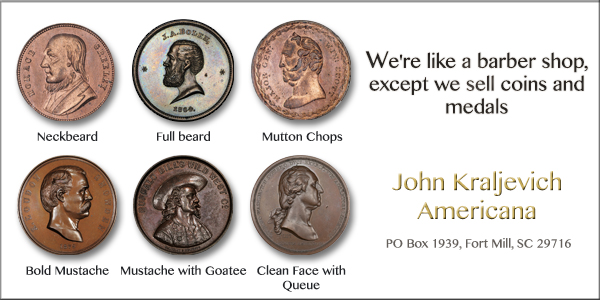
WILLIAM HARVEY AND COIN'S FINANCIAL SCHOOL
From Wikipedia:
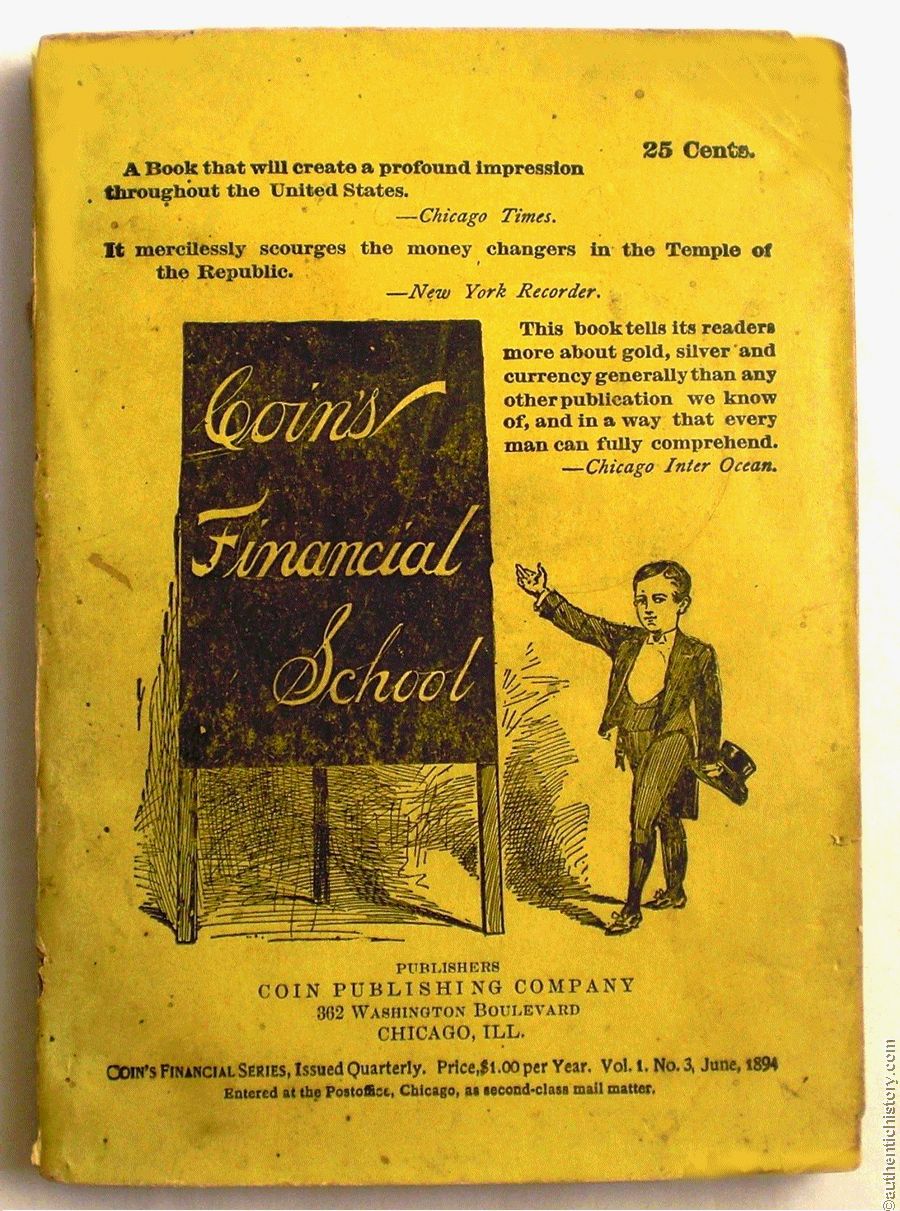 Coin's Financial School was a popular pamphlet written in 1894 that helped popularize the free silver and populist movements.
The author of the text "Coin", William Hope Harvey, would later go on to aid William Jennings Bryan in his bid for the
presidency and would run for the presidency himself in the 1930s. The book was remarkably popular in its day, selling an estimated 1
million copies.
Coin's Financial School was a popular pamphlet written in 1894 that helped popularize the free silver and populist movements.
The author of the text "Coin", William Hope Harvey, would later go on to aid William Jennings Bryan in his bid for the
presidency and would run for the presidency himself in the 1930s. The book was remarkably popular in its day, selling an estimated 1
million copies.
The thesis of Coin's Financial School is that London arranged the end of the free coinage of silver in 1873 because they had gold cornered and thus the large Civil War debt became payable in gold instead of silver. The Coinage Act of 1873 demonetized silver by allowing repayment of all debts in gold or silver at the option of the holder of the debt. The deflation resulting from the immediate removal of a significant portion of the nation's money supply affected agriculture and business severely.
To read the complete Wikipedia article, see:
Coin's Financial School
(http://en.wikipedia.org/wiki/Coin's_Financial_School)
William Hope “Coin” Harvey founded both the resort of Monte Ne (Benton County) and the Ozark Trails Association, establishing him as a pioneer in the promotion of Arkansas tourism. Harvey was also the 1932 Liberty Party nominee for the president of the United States.
Coin Harvey was born on August 16, 1851, on a farm near Buffalo, Virginia (now West Virginia), to Robert Trigg and Anna Hope Harvey. He attended the country schools and Buffalo Academy in 1865–67, and then briefly taught school. While teaching, he studied law and briefly attended Marshall College in Cabell County, West Virginia, in 1867. In 1870, he was admitted to the bar.
In 1884, Harvey took his family to Ouray, Colorado, where he operated the Silver Bell, one of the most productive silver mines in the Red Mountain district. When the price of silver fell, Harvey abandoned mining and, in 1888, moved his family to Pueblo, Colorado, where he practiced law, sold real estate, and helped develop the Mineral Palace, an ornate exposition hall. By 1891, the family moved to Ogden, Utah, where Harvey led the organization of an extravagant carnival that ended in financial failure.
In the early 1890s, as the nation entered a period of deflation, bank failures, bankruptcies, and farm foreclosures, Harvey turned his attention to the free silver issue. Like other western business leaders, he believed that abandoning the gold standard and returning to the free coinage of silver would restore prosperity. In 1893, Harvey moved his family to Chicago to devote his time to the cause. He began writing and lecturing, arguing that the U.S. Treasury should buy all silver offered at a set price and issue silver certificates backed by the deposits.
In 1894, Harvey wrote the tremendously successful book, Coin’s Financial School, in which a fictional young financier named “Coin” presented the arguments in favor of silver. This book brought him fame, fortune, and his nickname, “Coin.” Other publications followed, and Harvey became a spokesman for the free silver cause. During the 1896 presidential race, he campaigned for William Jennings Bryan, the Democratic free silver candidate. Bryan lost the election, but Harvey remained an influential political figure.
To read the complete article, see:
"Coin" Harvey (1851–1936)
(www.encyclopediaofarkansas.net/encyclopedia/entry-detail.aspx?entryID=1666)
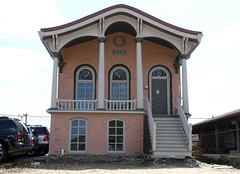 The Coin Harvey house as it has come to be known sits at 1305 3d Ave., in downtown Huntington. William Hope (Coin) Harvey built the house
in 1874 after visiting New Orleans. The thought is that he patterned it after the architecture he saw in several homes in that Louisiana
town. Consequently those homes were probably patterned after architecture found in the homes in Barbados.
The Coin Harvey house as it has come to be known sits at 1305 3d Ave., in downtown Huntington. William Hope (Coin) Harvey built the house
in 1874 after visiting New Orleans. The thought is that he patterned it after the architecture he saw in several homes in that Louisiana
town. Consequently those homes were probably patterned after architecture found in the homes in Barbados.
The house is unique in that it has a "bonnet" roofline and when it was built it was thought to have had a pair of curved iron staircases leading up to the front porch. Those and an iron balcony on the west side of the house were torn off in later years when Mr. Frank Enslow owned it.
The house is distinctive in that the walls are said "to have been built of oak planks and some would say oak blocks spiked together and covered with stucco."
To read the complete article, see:
Renovations continue at Coin Harvey
house (www.herald-dispatch.com/features/x1641587245/Renovations-continue-at-Coin-Harvey-house)
KEN POTTER'S MICHIGAN GOOD FOR TOKENS
 These "Good For" Tokens were minted in about 1983 by the late Del Romines. He
struck samples of them from three different obverse dies and one reverse. I waited too long to order and by the time I decided to got with
it, he had already turned the dies down and made new dies from them.
These "Good For" Tokens were minted in about 1983 by the late Del Romines. He
struck samples of them from three different obverse dies and one reverse. I waited too long to order and by the time I decided to got with
it, he had already turned the dies down and made new dies from them.
According to Del, only one of each of these tokens exists. He said that even his wife Joyce, who collected at least one of everything he made, got none.
Up until recently, when I went in and looked at them after 30 years, I had forgotten that I had this many pieces. I only remembered one in aluminum and two lead splashers.
As it turns out, there were three different obverse dies used with a common reverse. Obverse Die-1 was later modified creating two distinct obverse varieties for this one die.
They were all struck in aluminum (except the lead splashers) without a collar and vary in exact diameter with the average just over 34 mm for the aluminum specimens.
Obverse Die-1-A, was used for the lead splasher which shows Romines' designer's initials at the base of bust. It and Die-1-B are distinguished from the other two obverse dies by stars that separate "GOOD FOR $2 IN TRADE", which wraps along the upper rim, from "ON E/V COINS", which runs along the lower rim. It measures 38.27 mm.* Total mintage = 1.
Reverse Die-1, used for all tokens. The lead splasher of the reverse measures 36.7 mm.* Total mintage = 1.
Obverse Die 1-B, is a modification of Die-1 where Romines machined the base of bust down taking his initials with it. It measures 33.47 mm.* Total mintage = 1.
Obverse Die-2, exhibits the doubled LIBERTY far crisper and clearer than on the other two obverse dies. Romines' designer's initials are easily seen at the base of bust. The legend is spelled out as GOOD FOR $2 IN TRADE/ON VAR./ERROR COINS. It measures 34.55 mm.* Total mintage = 1.
Obverse Die-3, shows LIBERTY poorly defined, the central design is surrounded by a well-defined circle, the legend about the rim reads: GOOD FOR $2 ON ERROR/VAR. COINS .. It measures 34.2 mm.* Total mintage = 1.
The final piece was double-struck with a planchet set on top of the obverse of the token after the first strike and driven into it on the second strike. Del said this was an actual error. Other than the lead splashers, they were all struck on aluminum slugs. I think this was struck with Obverse Die-1-A. It measures 35.7 mm.* Total mintage for all errors = 1.
*Measurements taken with calipers from 12:00 O'clock and 6:00 O'clock + 3:00 O'clock and 9:00 O'clock divided by 2.
ILLINOIS TOLLWAY DROPPING COIN BUCKETS
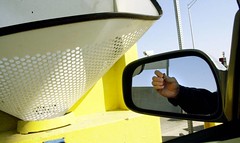 The Illinois tollway is expecting to retire its ubiquitous change buckets and replace them in a year
of so with updated machines that take credit cards.
The Illinois tollway is expecting to retire its ubiquitous change buckets and replace them in a year
of so with updated machines that take credit cards.
Most of the agency's automatic coin machines, which collect $14 million annually, are 20 years or older. The manufacturer went out of business, and spare parts are becoming difficult to find as breakdowns or failures increase.
"They're well past their useful life. It's very old technology," Business Systems Chief Shana Whitehead said at a Thursday meeting.
The agency is likely to switch to automatic toll payment machines that resemble bank machines but with openings for coins.
The replacements would take paper bills, accept credit cards, issue receipts and offer a touch screen to display rates. A connection to customer service would be provided, and interactions would be videotaped.
The move comes at a cost -- the machines could cost $100,000 each, according to estimates.
Not every tollway exit or entrance uses the coin machines. The system has 507 collection points overall with 102 buckets.
To read the complete article, see:
Tollway planning to kick the buckets of old coin collection
system (www.dailyherald.com/article/20150423/news/150429322/)
GOLD BAR RECOVERED FROM ARMORED CAR ROBBERY
 The FBI have recovered one of the gold bars stolen in a $5 million armored truck robbery in North Carolina
last month.
The FBI have recovered one of the gold bars stolen in a $5 million armored truck robbery in North Carolina
last month.
Investigators say the location the bar was found - somewhere in South Florida - has provided them with a big break in the case.
'This confirms that there is a South Florida nexus to this,' Justin E. Fleck, supervisory special agent of the squad leading the investigation, told ABC News.
'We believe that additional gold bars from the robbery may still be in South Florida and we continue to need the public’s help in solving this crime.'
The highway heist occurred on March 1 in Wilson County, almost halfway into the truck's journey from Miami to Boston.
Police have previously said they suspected it was an inside job because the 18-wheeler truck - owned by transport company TransValue - pulled over when one of the two armed guards on board 'felt sick'.
To read the complete article, see:
How a $500,000 gold bar recovered by police in Florida was the 'big break' in $5million North Carolina heist investigation
(www.dailymail.co.uk/news/article-3049308/One-500-000-bar-recovered-police-Florida-provides-big-break-5M-North-Carolina-gold-heist-investigation.html)
MACQUARIE MINT THREATENED OVER COPYRIGHTED IMAGE USE
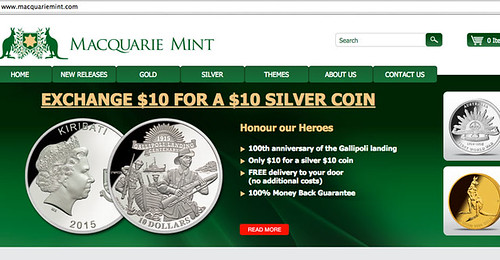
A Victorian souvenir coin maker has continued to unlawfully use the word ‘Anzac’ and the rising sun logo despite promising to stop.
On Friday morning, the website of Melbourne-based company Macquarie Mint prominently advertised a Gallipoli Landing-themed $10 silver coin.
“Macquarie Mint does not have permission to use the word Anzac for this purpose,” a Veterans Affairs spokesperson has confirmed.
The company had reportedly agreed to stop using the protected insignia after the Department of Veterans Affairs threatened a $51,000 fine on 21 April.
The word ‘Anzac’ and the rising sun badge cannot be used without prior written approval from the department.
Marketing material spruiking the coin, which claims to be legal tender on the Pacific island of Kiribati, has been sent to thousands of homes.
A further investigation has been launched, Veterans Affairs said.
To read the complete article, see:
Macquarie Mint continues to sell illegal Anzac coin
(http://thenewdaily.com.au/news/2015/04/24/mint-investigated-anzac-use/)
PNG SEEKS MORE NUMISMATIC INTERNS
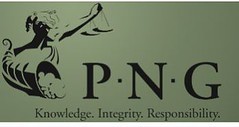 The Professional Numismatists Guild (www.PNGdealers.org) has issued a call for
more internship candidates to enroll in the organization's Promoting Numismatic Growth mentoring program. The PNG also is offering its
Edward Milas School of Numismatics online education courses to anyone, whether or not the person wants to enroll in the internship
program.
The Professional Numismatists Guild (www.PNGdealers.org) has issued a call for
more internship candidates to enroll in the organization's Promoting Numismatic Growth mentoring program. The PNG also is offering its
Edward Milas School of Numismatics online education courses to anyone, whether or not the person wants to enroll in the internship
program.
Launched last year, the Promoting Numismatic Growth project is intended to help nurture the next generation of professional numismatists. The program includes online instruction about coins, banknotes and the numismatic market, followed by a paid internship at a major numismatic company.
"We've been impressed with the caliber of applicants. Three interns were hired for full-time jobs well before they completed their internships," said PNG Executive Director Robert Brueggeman.
A total of ten prospective professional numismatists have enrolled in the program since last year. Internship applications now are being accepted from other candidates 21 to 32 years of age.
"Internship candidates who now successfully complete a background security check and the education components of the program will have the opportunity for a three to six month, paid internship at either Heritage Auctions or Numismatic Guaranty Corporation," explained Carol Raia, Administrator of the PNG mentoring program.
For the first time, PNG is offering its extensive online, multi-media internship education and training curriculum to anyone who wants to take the classes, not just internship candidates. There are two levels of online classes developed in conjunction with the University of Rare Coins.
Level 100 is designed to provide broad-based basic knowledge about numismatics. Topics include purchasing, selling, marketing and auctions; third-party certification; coin shows; and numismatic organizations and industry resources.
Level 200 topics include metallurgy and technology in the science of numismatics; the minting process and errors; and the history of monetary systems and development of coining.
The fee for applying for the internship program is $250 to cover the cost of a security background check and the Level 100 classes. The cost for Level 200 for intern candidates is an additional $250. Those who want only the online classes can enroll for a total fee of $300 that includes both Level 100 and 200.
Certificates of Completion will be provided to everyone who successfully completes both levels.
"The goal of this program is to ensure industry growth through the education and mentoring of future professional numismatists, and we've been quite happy with the results so far," said Terry Hanlon, PNG President.
Specific information about the internship program and educational courses is available at www.PNGdealers.org under the "Promoting Numismatic Growth" navigation links near the top of the PNG's home page. For additional information, contact the PNG by phone at (951) 587-8300 or by email at internship@PNGdealers.org.

Archives International Auctions, Part XXIV
U.S. and Worldwide Banknotes and Scripophily
Highlights include:
- Lot 168 Continental Currency April 11, 1778 $8 XF to AU, Crisp.
- Lot 399 Standard Consolidated Mining Co. 1881 Proof Stock Certificate with Coin Vignette.
- Lot 177 Government of Texas, 1838 Third Issue

1580 Lemoine Avenue, Suite #7
Fort Lee, NJ 07024
Phone: 201-944-4800
Email: info@archivesinternational.com
WWW.ARCHIVESINTERNATIONAL.COM
FEATURED WEB PAGE: COLLECTING U.S. TOKENS
This week's Featured Web Page is Bob Leonard's 1986 article, hosted on the Chicago Coin Club site, titled "Collecting U.S. Tokens: Challenges and Rewards".It is a curious fact that there is less known about many U.S. tokens of the 20th century than about most ancient and medieval coins. We are able to date coins minted 1,000, even 2,000 years ago more closely than a number of modern tokens, some users of which are still living. But it is this very opportunity for original research that attracts collectors of ancient, medieval, and Islamic coins to the study of modern tokens.
Token tracing is practically a hobby in itself, and more than one numismatist has commented that it is the greatest reward of token collecting. Usually old city directories are resorted to first, and reading them is an education in itself into how people lived at that time - what businesses they patronized, where they lived, what their occupations were, even what the rate of growth of the city was. But city directories are primarily useful for 19th century tokens; for more recent issues, Duns, Bradstreet's, and Dun & Bradstreet books are invaluable.
www.chicagocoinclub.org/projects/PiN/cut.html

